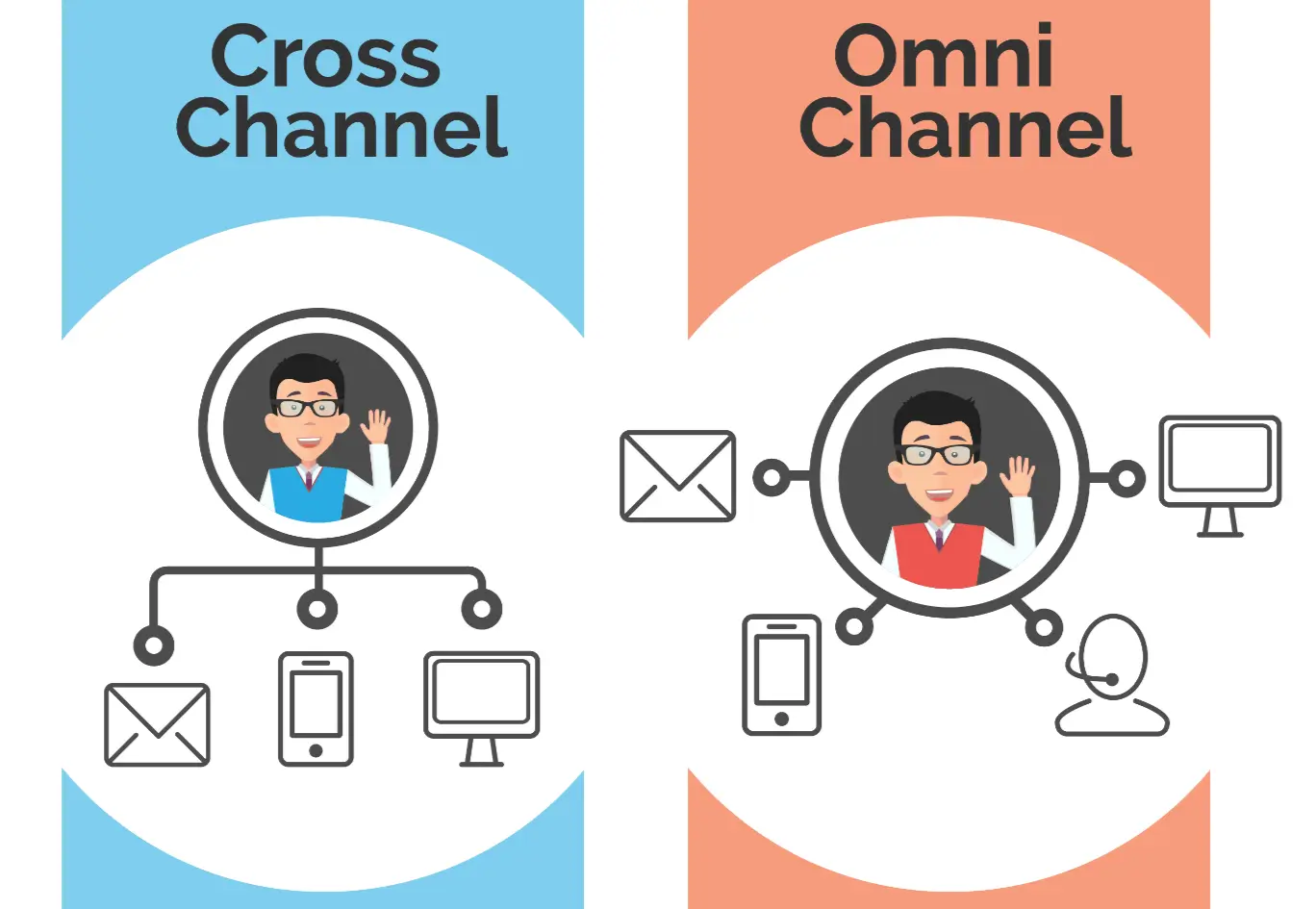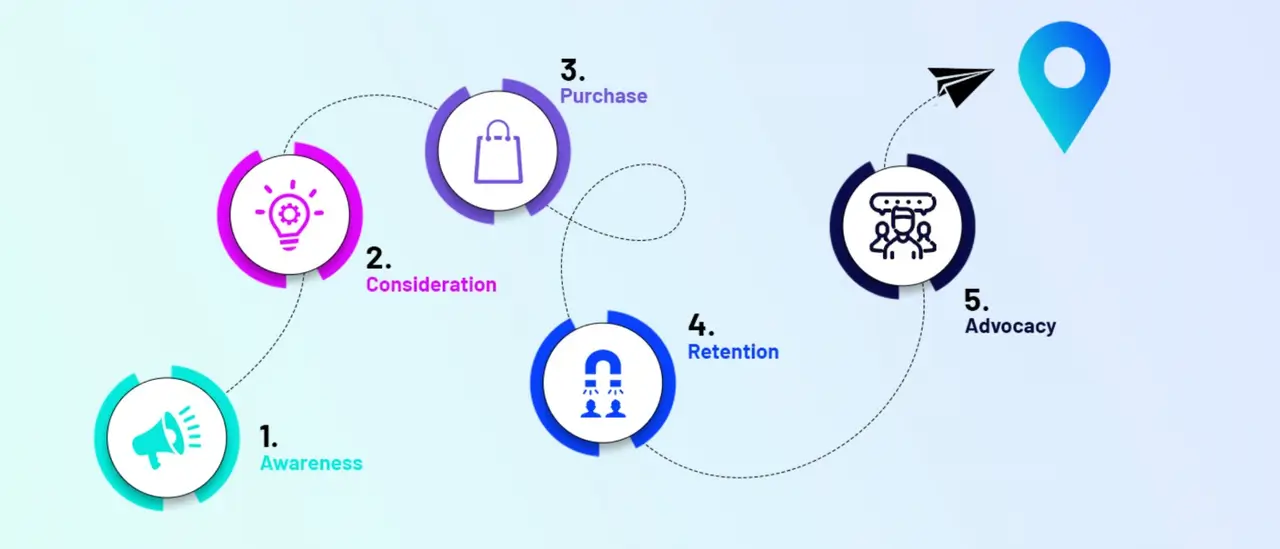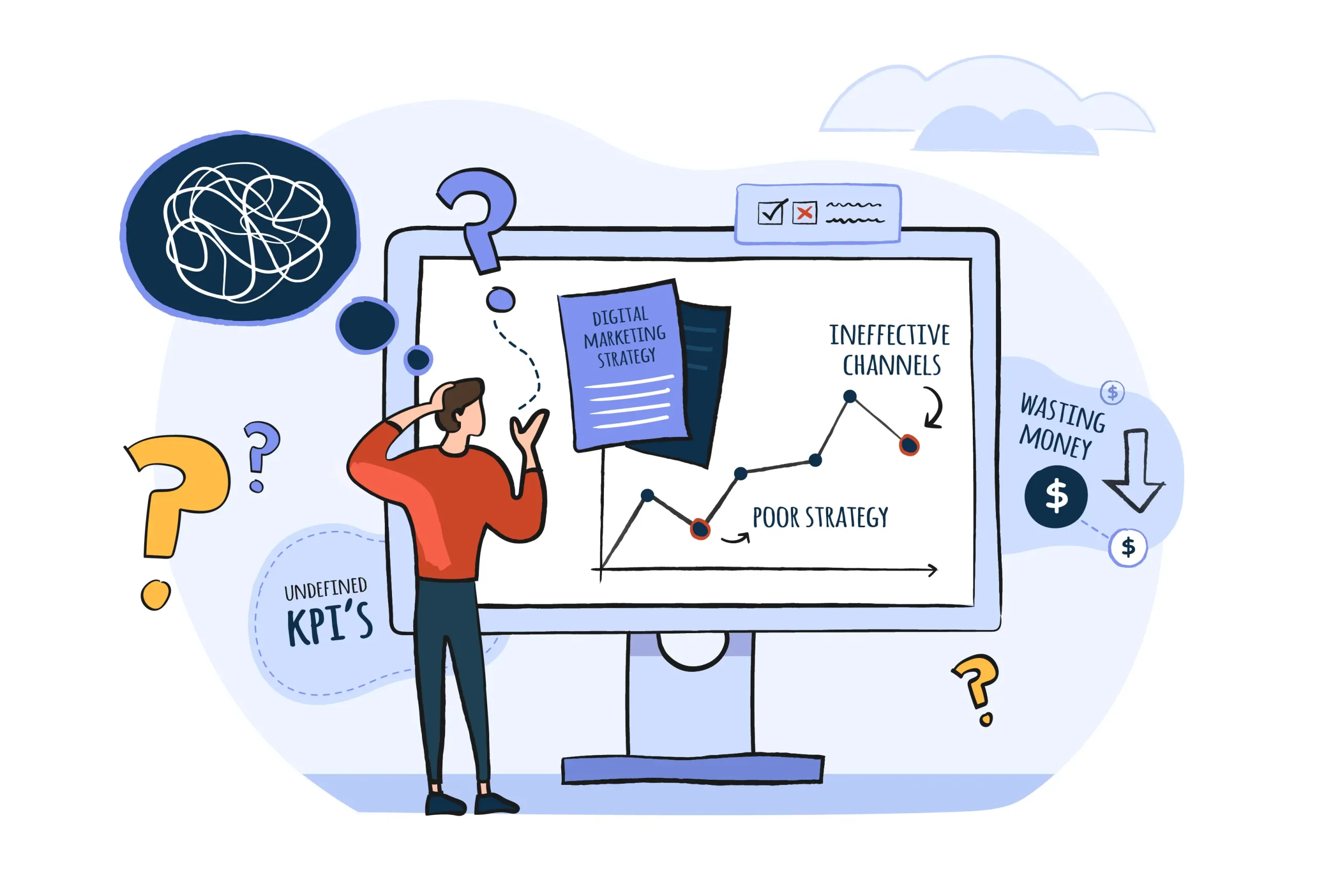A clear understanding of Omnichannel vs Cross Channel approaches allows businesses to tailor their strategies to meet these evolving consumer needs, ensuring that they not only retain customers but also enhance their overall shopping experience. In this blog post, we will explore these two concepts in detail, comparing their levels of integration, the benefits they offer, and the challenges they present, ultimately helping businesses determine which strategy is best suited for their goals.
Table of Contents
- Definition and Overview
- Understanding Cross Channel: A Step Towards Integration
- Understanding Omnichannel: The Pinnacle of Integration
- Comparative Analysis: Omnichannel vs Cross Channel
- Challenges of Implementing Omnichannel from Cross Channel
- Omnichannel vs Cross Channel: Strategic Considerations for Businesses
Definition and Overview
Omnichannel in eCommerce represents the pinnacle of channel integration, where every touchpoint in a customer’s journey is seamlessly connected, providing a unified experience regardless of the platform or device used. This strategy goes beyond mere channel coordination, focusing on creating a consistent and personalized experience that follows the customer across all interactions.
On the other hand, Cross Channel approaches also aim to create a cohesive customer journey but do so by coordinating interactions across various channels while allowing each channel to maintain some level of autonomy. This results in a cohesive but not fully unified customer experience.
Definition of Omnichannel
In the world of modern business, where customers interact with brands through a variety of touchpoints, the concept of omnichannel has emerged as a critical strategy for success. Omnichannel represents the highest degree of integration among channels, where the focus is on delivering a seamless and unified experience across all customer interactions. Unlike other strategies that may coordinate or connect different channels to varying extents, omnichannel ensures that every channel—whether online, offline, mobile, or in-store—works together in perfect harmony to provide a consistent and personalized journey for the customer.
At its core, omnichannel is about breaking down the silos that often exist between different channels. Traditionally, customers might encounter fragmented experiences depending on whether they are interacting with a brand online, through a mobile app, or in a physical store. Each of these channels might operate independently, leading to inconsistencies in messaging, branding, and the overall customer experience. However, omnichannel eliminates these inconsistencies by integrating all channels into a cohesive system. This integration ensures that customers receive the same high-quality experience, regardless of how they choose to engage with the brand.

One of the key aspects of omnichannel is its emphasis on the customer. The strategy is designed with the customer at the center, aiming to create a journey that feels natural, intuitive, and effortless. For example, a customer might start their shopping journey by researching a product on their smartphone, continue the process by visiting a physical store to see the product in person, and finally complete the purchase online. In an omnichannel environment, this entire journey is not only possible but also optimized. The customer’s preferences, browsing history, and previous interactions are seamlessly integrated across all channels, allowing the brand to offer personalized recommendations, consistent messaging, and a smooth transition from one channel to another.
The level of integration required for omnichannel is extensive. It involves the synchronization of various technologies, including CRM systems, data analytics platforms, and inventory management systems, among others. These technologies work together to provide a 360-degree view of the customer, enabling brands to understand and anticipate customer needs at every touchpoint. This deep level of integration is what sets omnichannel apart from other strategies, making it the gold standard for customer experience management.
In the debate of omnichannel vs cross channel, omnichannel is recognized as the more advanced and sophisticated approach. While cross channel strategies also aim to create a cohesive customer experience by linking multiple channels, they do so with less integration and coordination. Cross channel strategies might ensure that customers can move from one channel to another without losing their progress, but they often lack the full integration that allows for the personalized, seamless experience that omnichannel provides.
Definition of Cross Channel
Cross channel is a strategic approach that focuses on integrating multiple customer interaction channels to create a cohesive experience. Unlike omnichannel, where the aim is to deliver a seamless and fully unified experience across all touchpoints, cross channel strategies maintain distinct experiences within each channel while ensuring that these experiences are coordinated. The primary goal of cross channel is to guide customers smoothly from one channel to another, ensuring that each channel’s strengths are leveraged effectively without requiring full integration.
In a cross channel strategy, different channels—such as websites, mobile apps, physical stores, and customer service centers—are linked to facilitate a continuous customer journey. However, each channel retains its unique characteristics and operates somewhat independently. This means that while a customer might start their journey on a mobile app and complete it in a physical store, the experience in each channel may differ in terms of interface, available options, and specific interactions. The key to cross channel is that these interactions are coordinated to ensure consistency in messaging and functionality, even if the experience is not entirely unified.
For example, a business employing a cross channel strategy might send a customer a promotional email with a discount code that can be used online or in-store. When the customer visits the website, they can apply the discount code during checkout. Alternatively, if they choose to visit the store, they can present the code to the cashier. In this scenario, the online and in-store experiences are distinct—each channel may offer different products or services, and the way the discount is applied might vary—but the promotional message and the core offer remain consistent.

The level of integration in cross channel strategies is moderate compared to omnichannel. While channels are linked and work together, they are not fully integrated into a single, seamless system. This allows businesses to maintain flexibility and adapt to the specific needs of each channel, but it can also result in a less cohesive overall customer experience compared to omnichannel approaches. For instance, data collected in one channel, such as browsing behavior on a website, may not be fully accessible or utilized in another channel, like in-store interactions, which can lead to missed opportunities for personalization and engagement.
The debate of omnichannel vs cross channel often centers around the level of customer experience integration. While omnichannel aims for a fully unified experience, cross channel offers a coordinated but distinct journey across multiple platforms. This distinction is important for businesses to consider when deciding on their customer engagement strategies. Cross channel can be particularly effective for companies that operate in diverse markets or need to cater to different customer segments with varying preferences. It allows for tailored experiences within each channel, while still providing a coherent brand message.
In the context of the omnichannel vs cross channel discussion, it’s essential to recognize that cross channel strategies can be a stepping stone toward more integrated approaches. Businesses may start with cross channel efforts, linking their various platforms and ensuring a consistent message, before gradually moving towards a more unified, omnichannel experience as they develop the necessary technological infrastructure and data integration capabilities.
Importance of Understanding the Differences Between the Two Strategies
In the increasingly complex landscape of customer engagement, understanding the differences between omnichannel and cross channel strategies is crucial for businesses striving to stay competitive. As consumer behavior continues to evolve, driven by technological advancements and rising expectations, the choice between omnichannel and cross channel approaches can significantly impact a company’s ability to meet its customers’ needs and achieve long-term success. The debate of omnichannel vs cross channel is not merely academic; it has real-world implications for how businesses design their customer journeys, allocate resources, and integrate technology across various platforms.
At its core, the difference between omnichannel and cross channel lies in the level of integration and the overall customer experience. Omnichannel represents the highest degree of integration, where all customer interactions across different channels are unified into a seamless experience. This approach ensures that customers receive consistent messaging, branding, and service regardless of whether they are interacting with a brand online, through a mobile app, in a physical store, or via customer support. The goal of omnichannel is to create a holistic customer journey where each interaction feels like part of a single, continuous conversation.

On the other hand, cross channel strategies focus on integrating multiple channels while maintaining distinct experiences within each. This means that while channels are connected and work together to guide the customer from one platform to another, each channel retains its unique characteristics. In a cross channel approach, a customer might experience different interfaces, options, or even services depending on the channel they are using. However, these experiences are coordinated to ensure that the overall journey is coherent, even if it is not fully unified.
Understanding the differences between these two strategies is vital for several reasons:
- Customer Experience Optimization: One of the most significant distinctions in the omnichannel vs cross channel debate is how each strategy affects the customer experience. Omnichannel aims to provide a seamless, frictionless journey that makes customers feel recognized and valued across all touchpoints. This can lead to higher customer satisfaction, increased loyalty, and ultimately, better retention rates. In contrast, cross channel strategies offer a more flexible approach, allowing businesses to tailor each channel to specific customer segments or market conditions. While this can be advantageous in certain contexts, it may also lead to inconsistencies that could confuse or frustrate customers if not managed carefully.
- Resource Allocation and Technology Integration: The level of integration required for omnichannel versus cross channel strategies also has significant implications for resource allocation and technology integration. Omnichannel demands a more substantial investment in technology, such as CRM systems, unified data platforms, and advanced analytics tools, to ensure that customer data is shared and utilized across all channels. This approach can be resource-intensive, requiring both financial investment and organizational alignment. Cross channel, while still requiring coordination and some degree of technology integration, allows for greater flexibility in resource allocation. Businesses can focus on optimizing individual channels without the need for full-scale integration, making it a more accessible option for companies with limited resources.
- Strategic Flexibility and Adaptability: In the omnichannel vs cross channel comparison, another critical factor is strategic flexibility. Omnichannel strategies, due to their emphasis on uniformity and integration, can be less adaptable to changes in individual channels. For example, if a new social media platform emerges or a particular channel experiences a sudden surge in popularity, an omnichannel approach may require significant adjustments to incorporate this new touchpoint into the existing unified experience. Conversely, cross channel strategies are inherently more flexible, as they allow each channel to operate semi-independently. This means businesses can quickly adapt to new trends or changes in consumer behavior without overhauling their entire customer engagement strategy.
- Business Goals and Market Positioning: Finally, understanding the differences between omnichannel and cross channel is essential for aligning these strategies with a company’s broader business goals and market positioning. For businesses that prioritize providing a premium, highly personalized customer experience, omnichannel may be the better choice. This approach can help differentiate the brand and build deep, lasting customer relationships. On the other hand, businesses that operate in highly competitive or rapidly changing markets may benefit more from the agility and adaptability of a cross channel strategy, which allows them to respond swiftly to market dynamics and customer demands.
Understanding Cross Channel: A Step Towards Integration
Unlike the seamless experience promised by omnichannel strategies, cross channel focuses on creating a cohesive yet distinct experience across various customer touchpoints.
Core Concepts of Cross Channel
Cross Channel as an Intermediate Level of Channel Integration
At its core, cross channel serves as a bridge between the traditional multi-channel approach and the more advanced omnichannel strategy. While multi-channel strategies involve operating in multiple channels independently, and omnichannel seeks to unify all channels into a single, seamless experience, cross channel takes an intermediate position. In cross channel strategies, channels are linked and coordinated, but they do not require the full-scale integration that defines omnichannel.
This intermediate level of integration means that while each channel—such as a brand’s website, mobile app, physical store, and social media platforms—functions independently, they are strategically connected to ensure that the customer experience is coherent and aligned across these touchpoints. For example, a customer might begin their interaction by browsing products on a brand’s mobile app, receive a promotional email based on their browsing history, and then visit a physical store to complete the purchase. In a cross channel approach, these interactions are connected; the promotional email reflects the customer’s app activity, and the in-store experience acknowledges their prior interactions, but each channel remains distinct with its unique operational procedures and interfaces.
The primary advantage of this intermediate level of integration is that it allows businesses to provide a more connected and satisfying customer experience without the complexities and resource demands associated with full omnichannel integration. It offers a practical solution for companies that want to enhance their multi-channel strategies by linking channels in a way that improves customer engagement and retention, but without the need for the deep technological and organizational changes required by omnichannel.
The Goal of Creating a Cohesive Experience Across Multiple Channels
One of the fundamental goals of cross channel strategies is to create a cohesive customer experience across multiple channels, ensuring that customers receive a consistent message and service quality regardless of how they choose to interact with the brand. This is where cross channel differs significantly from both multi-channel and omnichannel strategies. While multi-channel approaches might treat each channel as a separate entity and omnichannel strives for seamless integration, cross channel focuses on coordination and alignment between channels.
In practice, this means that while each channel in a cross channel strategy may offer a different experience tailored to its strengths, these experiences are designed to complement each other and contribute to a unified overall journey. For instance, a customer might engage with a brand through its website, where they can access detailed product information and reviews. Later, they might receive a reminder via a mobile app about an item they showed interest in, with an offer to pick it up at a nearby store. When they visit the store, the staff could have access to their online wishlist or shopping cart, allowing them to provide personalized assistance. Each interaction is distinct, but they are all connected in a way that guides the customer smoothly from one channel to the next.
The coordination required to achieve this cohesion is a defining characteristic of cross channel strategies. Unlike omnichannel, where the goal is to create a unified experience where the boundaries between channels are blurred, cross channel maintains these boundaries but ensures they work together effectively. This approach allows businesses to leverage the unique strengths of each channel while still providing customers with a connected journey that feels intentional and thoughtful.
For example, a brand might use social media platforms to generate awareness and drive traffic to its website, where customers can explore products in more depth. The website might then encourage visitors to download the brand’s mobile app for exclusive offers and easier shopping on the go. If a customer uses the app to make a purchase, they might receive an invitation to visit a physical store for a personalized fitting or consultation. Each of these interactions is distinct and tailored to the specific channel, but they are all part of a broader strategy designed to guide the customer along a cohesive journey.
Less Integration Than Omnichannel
One of the key differences between omnichannel vs cross channel strategies is the level of integration required. Omnichannel demands a high degree of integration, where all channels are fully interconnected, sharing data in real-time to create a seamless experience. In contrast, cross channel strategies require less integration, which can be an advantage for businesses that may not have the resources or infrastructure to support a fully integrated system.
In a cross channel strategy, while channels are coordinated, they operate with a level of independence that allows them to be optimized for their specific purposes. This means that a company does not need to completely overhaul its existing systems to create a cross channel experience. Instead, it can focus on linking its channels in ways that enhance the customer journey without requiring full-scale integration.
For example, a company might choose to integrate its online and in-store inventory systems to allow customers to check product availability across both channels, but it may not need to integrate every aspect of its online and offline operations. Similarly, while customer data might be shared between channels to personalize marketing efforts, the level of integration might stop short of the full data synchronization required by an omnichannel approach.
This reduced need for integration makes cross channel a more accessible strategy for many businesses, particularly those that are looking to improve their multi-channel operations without the extensive investment required for omnichannel. It offers a way to enhance customer engagement and satisfaction by creating a more connected experience, while still allowing businesses to maintain flexibility in how they manage and optimize their channels.
The core concepts of cross channel highlight its role as an intermediate level of channel integration, aimed at creating a cohesive customer experience across multiple touchpoints with less integration than omnichannel. This strategy allows businesses to connect their channels in ways that improve customer engagement and satisfaction, while still maintaining the distinctiveness and operational independence of each channel. As companies continue to explore the omnichannel vs cross channel debate, understanding these core concepts will be crucial in determining the best approach to meet their customer engagement goals.
The Mechanics of Cross Channel Coordination
In the ongoing discussion of omnichannel vs cross channel, it’s essential to explore how cross channel strategies operate in practice. Unlike omnichannel, where the aim is full integration and a seamless experience, cross channel focuses on linking distinct channels in a way that maintains their individual strengths while providing a unified message and customer journey.
Coordinating Channels for Consistency
At the heart of cross channel coordination is the goal of delivering consistent messaging and experiences across multiple customer touchpoints. This requires a strategic approach where each channel—whether it’s a website, mobile app, email campaign, social media platform, or physical store—is aligned with the others in terms of branding, messaging, and functionality. However, unlike the fully integrated approach of omnichannel, cross channel strategies allow for variations in how each channel delivers content, interacts with customers, and facilitates transactions. The key is that these variations are coordinated so that they complement rather than conflict with each other.

For example, a business might run a promotional campaign that spans several channels: an email newsletter, social media ads, and in-store displays. While the content of the promotion may be adapted to suit the specific strengths of each channel (e.g., a visually appealing Instagram post vs. a detailed email with product links), the core message remains consistent across all platforms. This coordination ensures that customers receive a coherent experience, regardless of how they choose to interact with the brand.
One of the challenges in cross channel coordination is managing the different timelines, content formats, and user behaviors associated with each channel. Unlike omnichannel, where the goal is to create a uniform experience regardless of the channel, cross channel strategies must account for the unique characteristics of each platform while ensuring that the overall customer journey feels connected. This requires careful planning and execution, often involving cross-functional teams that work together to synchronize efforts across various channels.
The Role of Technology in Cross Channel Coordination
The successful implementation of cross channel strategies relies heavily on technology. While omnichannel approaches typically require advanced integration tools to unify all customer data and interactions into a single system, cross channel strategies utilize technology to link channels in a way that allows for coordinated yet distinct experiences. Several technological solutions are instrumental in enabling effective cross channel coordination:
- Marketing Automation Tools: These platforms are essential for managing and automating marketing efforts across different channels. Marketing automation tools allow businesses to create, deploy, and track campaigns across email, social media, websites, and more, ensuring that messaging remains consistent and timely. For instance, a marketing automation platform can trigger an email to be sent to a customer who abandons their cart online, while simultaneously showing them targeted ads on social media, thereby maintaining a cohesive cross channel strategy.
- Customer Relationship Management (CRM) Systems: CRM systems play a crucial role in cross channel strategies by storing and organizing customer data from various touchpoints. While omnichannel CRM systems focus on providing a unified view of the customer across all channels, cross channel CRMs are used to ensure that relevant customer information is accessible to each channel as needed. This allows for more personalized interactions within each channel, without requiring full data integration across the board.
- Channel-Specific Analytics: Analytics tools tailored to individual channels help businesses understand how each platform is performing and how customers are interacting with the brand. In a cross channel strategy, these analytics are used to inform decisions about how to coordinate messaging and experiences across different platforms. For example, if data shows that a particular product is trending on social media, a business might decide to highlight that product in their email campaigns or feature it more prominently on their website, thereby creating a connected but channel-specific strategy.
- Content Management Systems (CMS): A robust CMS is essential for managing content across multiple channels. In a cross channel approach, a CMS can be used to ensure that the content delivered on each platform is consistent with the brand’s overall messaging while allowing for the customization needed to suit the specific audience or format of each channel. For instance, a CMS can help ensure that a blog post shared on a company’s website is also adapted for a shorter, more visual format on social media.
- Integration Platforms: While cross channel strategies do not require the same level of integration as omnichannel approaches, integration platforms can still be valuable for linking different systems and ensuring that data flows smoothly between them. These platforms allow businesses to connect their CRM, marketing automation, and analytics tools, enabling more efficient coordination across channels.
Achieving Effective Cross Channel Coordination
Achieving effective cross channel coordination requires a clear understanding of the strengths and limitations of each channel and a strategic approach to leveraging these differences. Businesses need to carefully plan how each channel will contribute to the overall customer journey and ensure that all efforts are aligned to provide a consistent message and experience. This might involve setting up regular cross-functional meetings, using project management tools to track progress, and continuously analyzing data to refine and optimize the strategy.
All in all, the mechanics of cross channel coordination involve linking distinct customer interaction points in a way that maintains consistency in messaging and experience, while allowing each channel to operate independently. Technology plays a vital role in enabling this coordination, providing the tools necessary to automate, manage, and analyze efforts across multiple platforms. As businesses navigate the complexities of omnichannel vs cross channel strategies, understanding how to effectively coordinate channels in a cross channel approach will be key to delivering a connected, cohesive customer experience that enhances engagement and drives growth.
Benefits of Cross Channel as an Integrated Strategy
In the ongoing analysis of omnichannel vs cross channel approaches, it is crucial to understand the unique benefits that cross channel strategies offer as an integrated yet flexible approach to customer engagement. While both strategies aim to enhance the customer experience by linking multiple channels, cross channel provides distinct advantages that make it an attractive option for businesses seeking to optimize their reach, efficiency, and resource management without the full-scale integration required by omnichannel.
Improved Reach and Efficiency Through Targeted Use of Each Channel’s Strengths
One of the most significant benefits of cross channel as an integrated strategy is its ability to improve reach and efficiency by leveraging the strengths of each individual channel. Unlike omnichannel, which strives to create a seamless experience across all touchpoints, cross channel strategies allow businesses to tailor their approach to each channel, maximizing its unique capabilities while ensuring that the overall customer journey remains cohesive.

For example, a company might use social media to generate brand awareness and engage with a younger demographic, while employing email campaigns to nurture leads and drive conversions among an older audience. Simultaneously, the company’s website could serve as a central hub for detailed product information and customer reviews, and physical stores could provide an opportunity for customers to experience products firsthand. By strategically targeting each channel’s strengths, cross channel strategies enable businesses to reach a broader audience and engage them more effectively, without the need for the extensive integration demanded by omnichannel approaches.
This targeted use of channels also enhances efficiency. Since each channel is optimized for specific tasks, businesses can allocate resources more effectively, reducing waste and improving the overall return on investment (ROI) for their marketing efforts. For instance, a business might find that social media is particularly effective for generating initial interest, while in-store promotions are better suited for closing sales. By understanding and leveraging these dynamics, cross channel strategies allow businesses to allocate their efforts where they will have the greatest impact, improving both reach and efficiency.
Flexibility in Addressing Channel-Specific Needs While Maintaining Overall Coherence
Another key advantage of cross channel strategies in the omnichannel vs cross channel debate is the flexibility they offer in addressing channel-specific needs while maintaining overall coherence in the customer journey. Unlike omnichannel strategies, which require full integration and uniformity across all touchpoints, cross channel allows for greater adaptability. This means that businesses can tailor their approach to the specific characteristics and demands of each channel without compromising the consistency of the overall customer experience.
For instance, a business might find that its mobile app users prefer quick, on-the-go interactions, while desktop users are more inclined to engage with long-form content and detailed product descriptions. With a cross channel approach, the business can cater to these preferences by offering bite-sized content and easy navigation on the mobile app, while providing more in-depth information and features on the desktop site. At the same time, the core messaging and branding remain consistent across both platforms, ensuring that customers receive a coherent experience no matter which channel they use.
This flexibility is particularly valuable in dynamic markets, where consumer behaviors and preferences can shift rapidly. Businesses that adopt a cross channel strategy are better positioned to respond to these changes, adjusting their approach to each channel as needed without disrupting the overall customer journey. This adaptability can lead to increased customer satisfaction, as businesses are able to meet their customers where they are and provide the experiences they value most.
Better Resource Management Due to Lower Integration Requirements
In the omnichannel vs cross channel comparison, resource management is a critical factor that often tilts the scale in favor of cross channel strategies for many businesses. While omnichannel requires significant investment in technology, data integration, and organizational alignment to achieve full channel integration, cross channel strategies are generally more resource-efficient. This is because cross channel does not necessitate the same level of integration, allowing businesses to allocate resources more selectively and strategically.
For example, implementing an omnichannel strategy often involves integrating various customer data sources into a single system, ensuring real-time updates across all platforms, and maintaining consistency in every customer interaction. This can be resource-intensive, requiring substantial investments in CRM systems, data analytics tools, and IT infrastructure, as well as ongoing maintenance and updates to keep everything running smoothly.

In contrast, cross channel strategies allow businesses to manage their resources more effectively by focusing on linking channels without the need for full-scale integration. This means that businesses can invest in the specific tools and technologies that are most relevant to each channel, rather than spreading their resources thin across all touchpoints. For example, a company might invest in advanced analytics for its website and social media channels, while using simpler tools for email marketing and in-store promotions. This approach not only reduces costs but also allows businesses to allocate their resources where they will have the greatest impact.
Moreover, cross channel strategies offer the advantage of scalability. Businesses can start with a few key channels and gradually expand their efforts as their resources and capabilities grow, without the need for a complete overhaul of their customer engagement strategy. This makes cross channel an ideal choice for small and medium-sized businesses, as well as larger organizations that are looking to optimize their resource management.
Understanding Omnichannel: The Pinnacle of Integration
Omnichannel represents the highest level of channel integration, where every customer interaction is seamlessly connected across all touchpoints to create a unified and consistent experience. This approach ensures that whether customers engage online, in-store, or through other platforms, their journey is uninterrupted and tailored to their preferences.
Core Concepts of Omnichannel
Omnichannel is widely regarded as the highest degree of channel integration, where the primary objective is to deliver a seamless and unified experience across all customer touchpoints. Unlike cross channel strategies, which coordinate multiple platforms while maintaining distinct experiences, omnichannel is designed to eliminate the barriers between channels, creating a cohesive and interconnected customer journey.
Definition of Omnichannel as the Highest Degree of Channel Integration
Omnichannel represents the pinnacle of channel integration, where every interaction a customer has with a brand—whether online, in-store, through a mobile app, or via customer service—is seamlessly connected. This means that all channels operate as one, sharing information, customer data, and insights in real time to ensure that the customer experience is consistent, personalized, and uninterrupted. In the omnichannel vs cross channel comparison, omnichannel stands out because it does not just link channels; it fully integrates them into a single, unified ecosystem.

For instance, in an omnichannel approach, a customer might browse products on a brand’s website, receive personalized recommendations based on their browsing history, and then visit a physical store where those recommendations are instantly accessible to the sales staff. If the customer chooses to make a purchase in-store, the system updates their online profile immediately, ensuring that their purchase history is reflected across all channels. Later, the customer might receive a follow-up email with suggestions for complementary products or an offer tailored specifically to their preferences. Throughout this journey, the customer experiences a level of integration that ensures every interaction feels connected and part of a larger, coherent relationship with the brand.
The Philosophy of Creating a Seamless and Unified Experience Across All Touchpoints
At the heart of omnichannel is the philosophy of creating a seamless and unified experience across all customer touchpoints. This philosophy is driven by the recognition that modern consumers expect to engage with brands in a variety of ways, and they expect these interactions to be consistent, regardless of the platform or device they are using. In the omnichannel vs cross channel debate, the seamless nature of omnichannel is what sets it apart and makes it the preferred strategy for brands that prioritize customer experience.
The seamless experience in an omnichannel strategy is achieved through the meticulous integration of all channels, both digital and physical. This integration ensures that customers can move effortlessly from one channel to another without encountering any disruptions or inconsistencies. For example, a customer might start their shopping journey on a mobile app, add items to their cart, and then decide to complete the purchase on a desktop computer. In an omnichannel system, the cart contents, customer preferences, and even potential discounts are carried over seamlessly, creating a fluid transition between devices. This not only enhances the convenience for the customer but also reinforces the brand’s commitment to providing a superior, unified experience.
Moreover, omnichannel strategies leverage data to create personalized experiences that are tailored to each customer’s unique preferences and behaviors. By integrating customer data across all channels, brands can deliver personalized recommendations, targeted promotions, and relevant content that resonate with the customer at every stage of their journey. This level of personalization is a key component of the seamless experience that omnichannel aims to provide, and it is a significant factor in the strategy’s effectiveness in building customer loyalty and satisfaction.

Another critical aspect of the omnichannel philosophy is the emphasis on consistency in messaging and branding. In an omnichannel approach, every channel, from social media to email marketing to in-store displays, communicates the same core message and reflects the same brand identity. This consistency is crucial in reinforcing the brand’s image and ensuring that customers receive a coherent message, regardless of how they choose to interact with the brand. In the omnichannel vs cross channel comparison, this emphasis on consistency is often highlighted as one of the major advantages of omnichannel, as it helps to build a stronger, more recognizable brand presence.
The ultimate goal of omnichannel is to create a customer journey that feels natural, intuitive, and uninterrupted. Whether a customer is browsing products online, engaging with a brand on social media, or making a purchase in-store, the experience should feel like part of a continuous conversation with the brand. This is achieved through the deep integration of technology, data, and customer insights, all working together to create a unified experience that meets the customer’s needs at every touchpoint.
In conclusion, understanding the core concepts of omnichannel is essential for appreciating why it is considered the pinnacle of channel integration. The definition of omnichannel as the highest degree of integration highlights its superiority in providing a seamless and unified experience across all touchpoints. This philosophy of integration is what differentiates omnichannel from other strategies in the omnichannel vs cross channel debate, making it the preferred choice for businesses that seek to deliver exceptional customer experiences and build lasting relationships with their audience. As businesses continue to navigate the complexities of customer engagement, the adoption of omnichannel strategies will likely become increasingly important in staying competitive and meeting the ever-evolving expectations of modern consumers.
The Mechanics of Omnichannel Integration
How Data Integration Works Across Channels to Provide a Cohesive Experience
At the core of omnichannel integration is the seamless flow of data across all customer interaction points. This means that whether a customer is browsing a website, interacting with a brand on social media, shopping via a mobile app, or visiting a physical store, their data is continuously collected, synchronized, and utilized to enhance their experience. The key difference in the omnichannel vs cross channel comparison is that omnichannel strategies do not just connect channels—they fully integrate them, ensuring that data from every interaction is shared across the entire ecosystem.

For example, consider a customer who starts their shopping journey by researching products on a brand’s website. They might add items to their cart but not complete the purchase. Later, they visit the brand’s physical store, where the sales staff, equipped with access to the customer’s online activity, can assist them in locating the items they viewed online. If the customer makes a purchase in-store, this information is immediately updated in their online profile, which could then trigger a personalized follow-up email with recommendations for complementary products. This level of integration ensures that every interaction the customer has with the brand is informed by their previous behaviors and preferences, creating a truly cohesive experience.
Achieving this level of data integration requires robust technological infrastructure. All channels must be connected in real-time, allowing for the instantaneous exchange of information. This is where omnichannel strategies differ significantly from cross channel approaches, which may only link certain aspects of customer data across channels, leading to a more fragmented experience. In an omnichannel environment, data integration is complete, enabling brands to deliver a continuous and consistent experience regardless of how or where the customer chooses to interact.
The Role of Technology in Achieving Omnichannel Success
The success of an omnichannel strategy hinges on the effective use of technology. To achieve the deep integration required for omnichannel, businesses must invest in a range of technological solutions that facilitate the seamless flow of data and interactions across all platforms. Key technologies that play a pivotal role in the mechanics of omnichannel integration include CRM systems, unified customer databases, and advanced analytics tools.
- CRM Systems: CRM systems are the backbone of any omnichannel strategy. These platforms are designed to manage and analyze customer interactions and data throughout the entire customer lifecycle. In an omnichannel context, CRM systems are essential for integrating data from all channels, providing a unified view of the customer. This means that every piece of information—whether it comes from an online purchase, a social media interaction, or an in-store visit—is stored and accessible in a central location.
- By leveraging CRM systems, businesses can ensure that every customer interaction is informed by comprehensive, up-to-date data. For example, if a customer contacts customer service, the representative can instantly access the customer’s entire history with the brand, including past purchases, preferences, and any previous issues or inquiries. This enables the representative to provide personalized, contextually relevant assistance, further enhancing the customer experience. In the omnichannel vs cross channel comparison, this level of data accessibility and integration is a significant advantage of omnichannel strategies, as it allows for a more personalized and seamless customer journey.
- Unified Customer Databases: Unified customer databases are another critical component of omnichannel integration. These databases consolidate customer data from all touchpoints into a single, cohesive system. This ensures that customer information is consistent and up-to-date across all channels, enabling businesses to deliver a truly unified experience.
- In a typical retail scenario, a unified customer database might track a customer’s online browsing history, in-store purchases, social media interactions, and responses to email marketing campaigns. This information is then used to personalize future interactions, whether the customer is shopping online, visiting a store, or engaging with the brand through another channel. The real-time integration of data across channels allows businesses to anticipate customer needs, provide tailored recommendations, and create a seamless experience that feels continuous and connected.
- Advanced Analytics Tools: Advanced analytics tools are essential for making sense of the vast amounts of data generated by an omnichannel strategy. These tools help businesses analyze customer behavior across all channels, identify trends, and gain insights that can be used to optimize the customer experience. In the context of omnichannel vs cross channel, the ability to analyze and act on data from all channels in real-time is a major advantage of omnichannel strategies.
- For example, advanced analytics can reveal patterns in customer behavior, such as which products are frequently purchased together, which channels drive the most conversions, or how customer preferences change over time. Businesses can then use this information to refine their omnichannel strategy, such as by adjusting product recommendations, optimizing marketing campaigns, or enhancing the in-store experience. By continuously analyzing data from all channels, businesses can ensure that their omnichannel strategy remains dynamic, responsive, and aligned with customer expectations.
Benefits of Omnichannel as the Superior Integration Strategy
In the comparison of omnichannel vs cross channel, one of the most compelling arguments in favor of omnichannel lies in its benefits as a superior integration strategy. Omnichannel is designed to provide a seamless, cohesive experience for customers by fully integrating all touchpoints and interactions. This high level of integration offers several significant advantages that set it apart from cross channel strategies, particularly in terms of customer satisfaction, personalization, and long-term business growth.
Customer-Centric Approach That Increases Satisfaction and Loyalty
One of the primary benefits of omnichannel as a superior integration strategy is its customer-centric approach. In the omnichannel vs cross channel debate, omnichannel is recognized for its ability to place the customer at the center of all interactions. By integrating data and touchpoints, omnichannel strategies ensure that every aspect of the customer journey is designed to meet their needs and preferences, regardless of how or where they choose to engage with the brand.
This customer-centric approach significantly enhances customer satisfaction. In an omnichannel environment, customers experience a consistent and seamless journey across all channels, whether they are shopping online, interacting with a mobile app, or visiting a physical store. For example, a customer might start by browsing products on a brand’s website, add items to their cart, and later receive a reminder email or mobile notification prompting them to complete their purchase. If they decide to visit a store instead, the sales staff can access their online cart and assist them in finalizing the purchase in person. This level of integration ensures that customers feel recognized and valued at every step, which in turn fosters satisfaction and loyalty.

Loyalty is further strengthened by the consistency and reliability that omnichannel strategies provide. Customers are more likely to return to a brand that offers a seamless, hassle-free experience across all channels. When customers know they can expect the same high-quality service and personalized attention regardless of how they interact with the brand, they develop a deeper connection and are more likely to become repeat customers. This is a crucial advantage of omnichannel over cross channel strategies, where the customer experience might vary between channels, potentially leading to frustration or disengagement.
Enhanced Ability to Deliver Personalized Experiences Based on Unified Data
Another significant benefit of omnichannel as a superior integration strategy is its enhanced ability to deliver personalized experiences. The debate of omnichannel vs cross channel often centers around the ability to use customer data effectively. In an omnichannel approach, data from all customer interactions—whether online or offline—is unified and integrated into a single system. This unified data allows businesses to create highly personalized experiences that are tailored to each customer’s preferences, behaviors, and past interactions.
For instance, a customer who frequently purchases certain types of products online might receive personalized recommendations for similar items when they visit a physical store. Or, if a customer browses a specific product category on the brand’s mobile app, they might later receive targeted ads or emails featuring those products. The key difference between omnichannel and cross channel in this regard is that omnichannel uses a unified data system to ensure that these personalized interactions are consistent across all channels. In contrast, cross channel strategies might only use data within specific channels, resulting in less personalized and more fragmented customer experiences.
The ability to deliver personalized experiences based on unified data not only enhances customer satisfaction but also drives engagement. Customers are more likely to engage with a brand that understands their needs and provides relevant, timely content and offers. This personalized approach can also lead to increased conversions, as customers are more likely to make a purchase when they feel that the brand’s recommendations align with their preferences. In the omnichannel vs cross channel comparison, omnichannel’s superior ability to leverage data for personalization is a critical factor in its effectiveness as a customer engagement strategy.
Long-Term Business Growth Through Consistent Engagement and Retention
Long-term business growth is another major benefit of adopting an omnichannel strategy. In the omnichannel vs cross channel debate, one of the key advantages of omnichannel is its ability to drive consistent engagement and retention, which are essential for sustained business success. By providing a seamless and personalized customer experience, omnichannel strategies encourage customers to return to the brand repeatedly, leading to higher lifetime value and stronger customer relationships.
Consistent engagement is achieved through the seamless integration of all channels, which allows customers to interact with the brand in a way that feels natural and effortless. For example, a customer might start by researching a product on their smartphone, receive follow-up communications via email, and complete the purchase on a desktop computer. Each of these interactions is part of a continuous journey, with no disruptions or inconsistencies. This fluid experience keeps customers engaged with the brand over time, increasing the likelihood of repeat purchases and ongoing loyalty.

Retention is further supported by the personalized experiences that omnichannel strategies enable. When customers feel that a brand understands their needs and provides value through personalized recommendations, offers, and content, they are more likely to remain loyal to that brand. This loyalty translates into higher retention rates, which are crucial for long-term business growth. In contrast, cross channel strategies, which may not offer the same level of integration and personalization, might struggle to achieve the same level of retention and customer loyalty.
Moreover, omnichannel strategies contribute to long-term growth by providing businesses with a comprehensive understanding of customer behavior across all channels. This insight allows businesses to make data-driven decisions that can optimize marketing efforts, improve product offerings, and enhance the overall customer experience. By continuously refining their strategies based on unified data, businesses can stay ahead of market trends, anticipate customer needs, and maintain a competitive edge in their industry.
All in all; in the omnichannel vs cross channel comparison, the benefits of omnichannel as a superior integration strategy are clear. Omnichannel’s customer-centric approach increases satisfaction and loyalty by providing a seamless, consistent experience across all touchpoints. Its enhanced ability to deliver personalized experiences based on unified data drives engagement and conversions, while its focus on consistent engagement and retention supports long-term business growth. As businesses continue to navigate the complexities of modern customer engagement, the advantages of omnichannel strategies will likely play a critical role in their ability to build lasting customer relationships and achieve sustained success.
Comparative Analysis: Omnichannel vs Cross Channel
The comparative analysis of omnichannel vs cross channel highlights the key differences in the degree of integration each strategy offers, with omnichannel providing a more seamless and unified customer experience through deeper integration, while cross channel focuses on coordinated but less integrated touchpoints.
Degree of Integration
Omnichannel: The Pinnacle of Integration
Omnichannel is designed to offer a fully integrated experience where every customer interaction is connected across all channels. In an omnichannel environment, data, customer profiles, and communication are seamlessly synchronized, ensuring that whether a customer is shopping online, visiting a physical store, or interacting via a mobile app, their experience is consistent and uninterrupted. This level of integration requires that all channels share a common infrastructure and data system, enabling real-time updates and a unified view of the customer.

For example, if a customer adds items to their shopping cart on a brand’s website and later visits the brand’s physical store, an omnichannel strategy would allow the store’s sales staff to access the customer’s online cart and assist them in completing the purchase in-store. Additionally, any promotions or discounts the customer is eligible for would be automatically applied across all channels, ensuring a consistent and personalized shopping experience. The result is a fluid, cohesive journey that feels seamless to the customer, regardless of how they interact with the brand.
This high degree of integration is a key advantage of omnichannel in the omnichannel vs cross channel comparison. By providing a unified experience, omnichannel strategies not only enhance customer satisfaction but also build stronger, more loyal customer relationships. Customers appreciate the convenience and consistency of an omnichannel approach, which reduces friction and makes their interactions with the brand more enjoyable and efficient.
Cross Channel: Coordinated, But Less Integrated
In contrast, cross channel strategies offer a more moderate level of integration. While cross channel aims to create a cohesive experience by linking multiple channels, it does so with less emphasis on full-scale integration. Each channel in a cross channel strategy operates somewhat independently, with its own data systems and customer interactions. However, these channels are still coordinated to ensure that the customer journey is coherent and that messaging and branding are consistent across platforms.
For instance, a cross channel approach might involve a customer receiving a promotional email that links to the brand’s website, where they can browse products and add items to their cart. Later, the customer might receive a follow-up notification via a mobile app, encouraging them to complete their purchase. If they choose to visit a physical store, the in-store staff might be aware of the promotion but may not have direct access to the customer’s online activity. While the channels are connected and the overall experience is aligned, the integration is not as deep or seamless as in an omnichannel strategy.
The more limited integration of cross channel strategies means that customers might encounter inconsistencies or gaps in their experience. For example, if a customer’s cart is not accessible across all channels, they may have to reselect items or miss out on personalized offers that were available online but not in-store. These discrepancies can lead to frustration and a less satisfying customer experience. However, cross channel strategies can still be effective for businesses that want to improve their multi-channel efforts without the extensive resources required for full omnichannel integration.
The Impact on Business Operations
The degree of integration in omnichannel vs cross channel strategies also significantly affects business operations. Omnichannel strategies require a higher level of investment in technology, infrastructure, and organizational alignment. Businesses must ensure that all systems are integrated, with real-time data sharing across channels. This can involve significant costs and resources, including the implementation of advanced CRM systems, unified databases, and robust analytics tools. However, the benefits of this investment are substantial, as it allows businesses to offer a superior customer experience, gain deeper insights into customer behavior, and make data-driven decisions that enhance overall performance.

In contrast, cross channel strategies are generally less resource-intensive, as they do not require the same level of integration. Businesses can achieve a coordinated customer journey by linking existing systems and aligning their efforts across channels without the need for full-scale integration. This makes cross channel a more accessible option for businesses with limited resources or those that are not ready to commit to the extensive changes required for omnichannel. However, the trade-off is that the customer experience may not be as seamless or consistent, and businesses may miss out on the deeper insights and efficiencies that come with a fully integrated approach.
Customer Experience and Journey Mapping
When examining the nuances of omnichannel vs cross channel strategies, one of the most critical aspects to consider is the impact each approach has on customer experience and journey mapping. These two strategies, while both aiming to enhance the customer journey across multiple touchpoints, do so in distinctly different ways. Understanding these differences is crucial for businesses looking to optimize how they engage with their customers and guide them through their buying journey.
Omnichannel: Unified, Consistent Experience Across All Touchpoints
Omnichannel is designed to deliver a unified and consistent customer experience across all touchpoints, ensuring that every interaction a customer has with a brand is part of a seamless, interconnected journey. In an omnichannel strategy, the boundaries between channels are effectively removed, allowing customers to move fluidly from one touchpoint to another without experiencing any disruptions or inconsistencies.
For instance, a customer might begin their journey by browsing products on a brand’s mobile app, continue by receiving personalized email recommendations based on their app activity, and ultimately complete their purchase in a physical store. Throughout this process, their preferences, browsing history, and even items left in their online cart are accessible and consistent across all platforms. This seamless integration means that the customer feels as though they are interacting with a single, cohesive entity, regardless of the specific channel they are using at any given time.

The unified nature of omnichannel strategies also extends to the brand’s messaging, promotions, and overall customer engagement tactics. Whether a customer is interacting with a brand via social media, email, in-store, or through customer service, the tone, style, and content remain consistent. This level of consistency not only reinforces the brand’s identity but also enhances customer trust and loyalty. Customers are more likely to engage with a brand that offers a reliable and predictable experience, where they know what to expect and feel confident that their needs will be met regardless of the channel.
Another key advantage of the unified experience in omnichannel strategies is the ability to personalize interactions on a deeper level. Because all customer data is integrated and accessible across all channels, businesses can tailor their messaging and offers to the individual customer’s preferences and behaviors. For example, a customer who frequently purchases a particular type of product might receive targeted promotions for similar items both online and in-store, with the brand recognizing and rewarding their loyalty across all platforms. This level of personalization is a powerful tool in building customer satisfaction and loyalty, as it shows that the brand understands and values the customer’s unique needs and preferences.
Cross Channel: Cohesive but Distinct Experiences, With Coordination Between Channels
In contrast to the seamless integration of omnichannel strategies, cross channel approaches offer a cohesive but distinct customer experience across multiple touchpoints. In the context of omnichannel vs cross channel, the key difference lies in the degree of integration and coordination between channels. While cross channel strategies aim to create a connected journey for the customer, each channel operates somewhat independently, with its own specific features and functionalities. However, these channels are still coordinated to ensure that the customer’s journey is logical and cohesive.
For example, a customer might receive an email promotion that directs them to the brand’s website to learn more about a product. After browsing the website, they might choose to visit a physical store to see the product in person and make a purchase. While the email, website, and in-store experience are all aligned in terms of branding and messaging, the way the customer interacts with each channel may differ. The website might offer more detailed product information, while the in-store experience focuses on tactile engagement and personal assistance from sales staff. The customer’s journey is cohesive in the sense that all channels work together to guide them towards a purchase, but each touchpoint offers a distinct experience tailored to the strengths of that specific channel.
The coordination in cross channel strategies is crucial in ensuring that, despite the distinct nature of each channel, the overall customer experience remains smooth and connected. For instance, if a customer abandons their cart on the website, a cross channel strategy might trigger a follow-up email reminding them to complete their purchase, or even a targeted social media ad encouraging them to return to the site. While these channels may not be fully integrated in real-time, they are still working in concert to move the customer along their journey in a cohesive manner.
However, because cross channel strategies involve less integration than omnichannel, there can be variations in the customer experience from one channel to the next. For example, the customer might find that the promotions they see online are not available in-store, or that their online browsing history does not carry over to their in-store interactions. These discrepancies can sometimes create friction in the customer journey, particularly if the transitions between channels are not as smooth as they would be in an omnichannel environment.
Despite these challenges, cross channel strategies can still be highly effective, particularly for businesses that want to offer a connected customer experience without the resource-intensive demands of full omnichannel integration. By focusing on coordinating efforts across channels, businesses can create a journey that feels intentional and supportive, even if it lacks the seamlessness of omnichannel. This approach allows for flexibility in how each channel operates while still maintaining an overall cohesive strategy that guides the customer from awareness to purchase.
The Impact on Customer Experience and Journey Mapping
The differences in customer experience and journey mapping between omnichannel vs cross channel have significant implications for how businesses engage with their customers. Omnichannel strategies, with their emphasis on a unified and consistent experience, are ideal for brands that want to offer a seamless, highly personalized journey that builds strong customer loyalty. The deep integration required for omnichannel ensures that every touchpoint contributes to a cohesive whole, making it easier for customers to navigate their journey and engage with the brand on their own terms.
Cross channel strategies, on the other hand, offer a more flexible approach that can be tailored to the unique strengths of each channel. While the experience may not be as seamless as in an omnichannel strategy, cross channel approaches still provide a connected and logical journey that can be highly effective in driving conversions and customer engagement. The key to success with cross channel strategies is ensuring that the coordination between channels is strong enough to maintain a cohesive experience, even if the integration is not as deep.

Ultimately, the choice between omnichannel vs cross channel will depend on a business’s specific goals, resources, and customer expectations. Brands that prioritize a seamless, personalized experience and have the resources to invest in full integration may find that omnichannel offers the best results.
On the other hand, businesses looking for a more flexible, less resource-intensive approach may find that cross channel strategies provide the right balance of coordination and independence to meet their needs. Regardless of the approach, understanding the impact on customer experience and journey mapping is essential for creating a strategy that resonates with customers and drives long-term success.
Data Utilization and Integration
In the ongoing comparison of omnichannel vs cross channel strategies, one of the most significant differentiators lies in how data is utilized and integrated across customer touchpoints. Data is the lifeblood of modern customer engagement, driving personalized experiences, targeted marketing, and informed decision-making. However, the degree to which data is integrated and shared between channels varies significantly between omnichannel and cross channel approaches, leading to distinct outcomes in customer experience and operational efficiency.
Omnichannel: Fully Integrated Data Providing a 360-Degree View of the Customer
Omnichannel strategies are built on the foundation of fully integrated data systems that provide a comprehensive, 360-degree view of the customer. In an omnichannel approach, data from every customer interaction—whether online, in-store, via mobile app, or through social media—is captured, synchronized, and made accessible across all channels in real time. This level of integration ensures that every touchpoint has access to the most up-to-date and relevant customer information, allowing for a seamless, personalized experience that reflects the customer’s entire history with the brand.
For example, consider a customer who browses products on a brand’s website, adds items to their cart, but does not complete the purchase. Later, they visit a physical store, where the sales associate can immediately access the customer’s online cart, see their browsing history, and offer personalized assistance based on this data. If the customer decides to make a purchase in-store, the transaction is instantly reflected in their online profile, which may trigger a follow-up email with suggestions for complementary products or a thank-you message. This seamless flow of data across all channels is a hallmark of omnichannel strategies, ensuring that the customer experience is consistent, cohesive, and deeply personalized.

The fully integrated data in omnichannel strategies allows businesses to gain a holistic understanding of each customer’s preferences, behaviors, and needs. This 360-degree view enables more accurate and effective personalization, as every interaction is informed by the customer’s entire journey with the brand. Whether it’s recommending products, tailoring promotions, or providing customer support, omnichannel strategies leverage this integrated data to deliver experiences that resonate with customers on a personal level, fostering loyalty and satisfaction.
Moreover, the deep integration of data in omnichannel strategies facilitates advanced analytics and reporting. Businesses can track customer behavior across all channels, identify trends, and gain insights that inform strategic decisions. For example, a brand might use data from both online and offline channels to analyze the effectiveness of a new product launch, adjusting marketing efforts in real time based on customer response. This ability to analyze and act on data from a unified system gives businesses a significant competitive advantage, as they can respond more quickly and accurately to customer needs and market changes.
Cross Channel: Data Used Within Specific Channels, With Limited Integration
In contrast, cross channel strategies typically involve the use of data within specific channels, with limited integration between them. While cross channel approaches aim to create a cohesive customer experience by coordinating efforts across multiple platforms, the data used to inform these efforts is often siloed within individual channels. This means that while each channel can leverage data to personalize and optimize the customer experience, the information is not necessarily shared or integrated across all touchpoints.
For example, a customer might receive a promotional email based on their recent online browsing history, which directs them to the brand’s website to complete a purchase. If the customer later visits a physical store, the sales staff may not have access to the customer’s online activity, meaning they cannot offer the same level of personalized assistance. Similarly, if the customer makes a purchase in-store, this information may not be immediately reflected in their online profile, leading to discrepancies in the data available to different channels.
This limited integration of data in cross channel strategies can result in a less seamless and consistent customer experience compared to omnichannel. Customers may encounter situations where their preferences, past interactions, or purchase history are not fully recognized or utilized across all touchpoints, leading to potential frustration or missed opportunities for engagement. For example, a customer who frequently purchases a specific type of product online might not receive targeted offers for similar items when shopping in-store, simply because the data is not integrated across channels.
However, cross channel strategies still offer valuable benefits, particularly for businesses that may not have the resources or infrastructure to support full data integration. By using data within specific channels, businesses can still create personalized and targeted experiences that enhance customer engagement. For instance, a retailer might use data from their email marketing platform to send personalized promotions, while their website offers tailored product recommendations based on browsing history. While these efforts are not fully integrated, they can still contribute to a cohesive and effective customer journey.
The primary challenge with cross channel data utilization is ensuring that the coordination between channels is strong enough to maintain a consistent experience, even without full integration. This requires careful planning and communication between different teams and systems to ensure that messaging, promotions, and customer interactions are aligned. While this approach may not offer the same level of personalization and seamlessness as omnichannel, it can still be effective in driving engagement and conversions when executed well.
The Impact of Data Utilization
The differences in data utilization and integration between omnichannel vs cross channel have significant implications for both customer experience and business operations. Omnichannel’s fully integrated data systems enable a seamless, personalized experience that enhances customer satisfaction and loyalty. Customers appreciate the consistency and relevance of their interactions with the brand, as they feel recognized and valued across all touchpoints. This level of integration also allows businesses to operate more efficiently, with real-time data and insights that inform decision-making and optimize performance across all channels.
On the other hand, cross channel strategies, with their more limited data integration, may offer a less consistent customer experience, but they can still be effective for businesses that prioritize flexibility and targeted engagement within specific channels. While the customer journey may not be as seamless as in an omnichannel approach, cross channel strategies can still create a cohesive experience by ensuring that each touchpoint is optimized and aligned with the brand’s overall objectives.

The degree of data utilization and integration is a key factor that differentiates omnichannel vs cross channel strategies. Omnichannel’s fully integrated data systems provide a 360-degree view of the customer, enabling seamless, personalized experiences and data-driven decision-making. Cross channel strategies, while offering more limited integration, still allow businesses to leverage data within specific channels to create targeted and effective customer engagements. The choice between these approaches will depend on a business’s resources, goals, and the level of customer experience they wish to deliver.
Technological Requirements
The debate of omnichannel vs cross channel is not only about the strategic approaches to customer engagement but also about the technological infrastructure required to implement these strategies effectively. The technological requirements for omnichannel and cross channel strategies differ significantly, impacting both the complexity of implementation and the associated costs. Understanding these differences is crucial for businesses as they consider which approach best aligns with their capabilities and objectives.
Omnichannel: Requires Advanced, Often Expensive Technology for Seamless Integration
Omnichannel strategies are characterized by their seamless integration across all customer touchpoints, a feat that requires a sophisticated and often expensive technological infrastructure. The goal of omnichannel is to create a unified customer experience where every interaction, whether online or offline, is connected and informed by a comprehensive, real-time understanding of the customer’s preferences, behaviors, and history. Achieving this level of integration necessitates the use of advanced technologies that can synchronize data across all channels, provide real-time insights, and facilitate personalized interactions at every touchpoint.
One of the core technological requirements for omnichannel is a robust CRM system. A CRM in an omnichannel environment must be capable of aggregating data from multiple sources, including e-commerce platforms, in-store point-of-sale systems, mobile apps, social media, and customer service interactions. This data is then centralized within the CRM, providing a 360-degree view of each customer. Such a system allows businesses to track the entire customer journey, from initial contact to post-purchase support, and to tailor their marketing, sales, and service efforts accordingly. However, implementing and maintaining a CRM system that supports omnichannel capabilities can be costly, both in terms of the software itself and the ongoing resources needed to manage and analyze the data.

In addition to CRM systems, omnichannel strategies often require advanced data analytics platforms that can process and interpret the vast amounts of information generated across channels. These platforms must be capable of real-time data processing to ensure that customer interactions are informed by the most current information. For example, if a customer interacts with a brand via a mobile app, the data from that interaction should immediately influence the content they see when they later visit the brand’s website or enter a physical store. Real-time analytics enable this kind of dynamic, personalized experience, but they also demand significant computational power and sophisticated algorithms, further increasing the technological investment required for omnichannel.
Another critical technological component of omnichannel is the integration of inventory management systems across all sales channels. In a fully integrated omnichannel environment, inventory levels must be updated in real time across all platforms, ensuring that customers have accurate information regardless of whether they are shopping online, in a store, or through a mobile app. This requires a high level of synchronization between different systems, such as warehouse management software, e-commerce platforms, and point-of-sale systems. The complexity of integrating these systems often necessitates custom development and ongoing IT support, adding to the overall cost of implementing an omnichannel strategy.
Moreover, omnichannel strategies often require investment in personalized marketing automation tools. These tools use customer data to deliver tailored messages and offers across all channels, ensuring that each customer receives the most relevant content based on their unique journey. The automation of these processes not only improves the efficiency of marketing efforts but also enhances the customer experience by providing a seamless and personalized interaction at every touchpoint. However, like other omnichannel technologies, marketing automation platforms that support omnichannel capabilities can be expensive and require continuous optimization to deliver the desired results.
Cross Channel: More Flexible and Less Costly Technology Solutions
In contrast to the advanced technological demands of omnichannel, cross channel strategies generally require more flexible and less costly technology solutions. While cross channel approaches still aim to create a cohesive customer experience by linking multiple touchpoints, they do so with less emphasis on full-scale integration. This allows businesses to implement cross channel strategies using a more modular and cost-effective technological infrastructure.
One of the key technological requirements for cross channel strategies is the ability to coordinate efforts across different platforms, even if they operate somewhat independently. For example, a business might use separate systems for its e-commerce website, email marketing, and in-store point-of-sale, but these systems are connected enough to ensure a consistent customer experience. This coordination can be achieved using simpler integrations, such as API connections or third-party software that bridges different platforms. While these integrations may not provide the real-time synchronization and seamless data flow of an omnichannel system, they are often sufficient for maintaining consistency across channels and guiding the customer journey.

Cross channel strategies also benefit from the use of less complex CRM systems compared to omnichannel. While a cross channel CRM still needs to manage customer data from multiple sources, it does not require the same level of integration or real-time processing. This allows businesses to use more affordable CRM solutions that offer the necessary functionality without the high costs associated with omnichannel CRM systems. Additionally, businesses can opt for cloud-based CRM platforms that offer scalability and flexibility, allowing them to expand their cross channel capabilities as needed without a significant upfront investment.
Another advantage of cross channel strategies is the ability to use more specialized tools for specific channels without the need for full integration. For instance, a business might use a dedicated email marketing platform that excels in automation and personalization but operates independently of the in-store point-of-sale system. While this approach may result in some data silos, it allows businesses to leverage the best tools for each channel without the cost and complexity of integrating them into a single omnichannel system.
Furthermore, cross channel strategies typically involve lower costs in terms of inventory management and logistics. Since cross channel does not require real-time synchronization of inventory across all platforms, businesses can use simpler inventory management solutions that provide adequate functionality without the need for extensive customization. This not only reduces the technological burden but also simplifies operations, making cross channel a more accessible option for businesses with limited resources.
In summary, the technological requirements of omnichannel vs cross channel strategies reflect the differences in their level of integration and the customer experience they aim to deliver. Omnichannel demands advanced, often expensive technology to create a seamless, real-time, and fully integrated customer journey across all touchpoints. In contrast, cross channel strategies offer a more flexible and cost-effective approach, using modular technology solutions that coordinate efforts across channels without the need for full integration. Businesses must carefully consider these technological demands when choosing between omnichannel and cross channel strategies, as the right approach will depend on their resources, objectives, and the level of customer experience they wish to provide.
Strategic Flexibility
When evaluating omnichannel vs cross channel strategies, one of the critical factors that businesses must consider is the degree of strategic flexibility each approach offers. Strategic flexibility refers to the ability of a business to adapt its strategies and operations in response to changing market conditions, customer behaviors, and technological advancements. The level of flexibility inherent in omnichannel and cross channel strategies differs significantly, influencing how businesses can respond to these changes while maintaining effective customer engagement.
Omnichannel: Less Flexibility Due to the Need for Consistency Across All Channels
Omnichannel strategies are designed to provide a seamless, consistent experience across all customer touchpoints, which inherently requires a high level of coordination and integration. This consistency is one of the core strengths of omnichannel, as it ensures that customers receive a unified experience regardless of how they interact with the brand. However, this need for consistency can also limit the strategic flexibility of an omnichannel approach.
In an omnichannel strategy, all channels must be tightly integrated and aligned, meaning that any changes or adaptations to one channel often necessitate corresponding adjustments across all other channels. For example, if a brand decides to introduce a new promotion or update its branding, these changes must be implemented uniformly across every platform, from the website and mobile app to physical stores and customer service channels. This level of coordination requires significant planning, resources, and time, making it challenging for businesses to quickly adapt to new opportunities or respond to market shifts.
Moreover, the deep integration of systems and data required by omnichannel strategies can further constrain flexibility. Because all customer interactions and data are interconnected, any changes to the underlying technology or processes can have widespread implications. For instance, upgrading a CRM system in an omnichannel environment might necessitate updates to the e-commerce platform, inventory management system, and customer service tools to ensure continued integration. This interconnectedness can slow down the pace at which a business can implement new strategies or adopt innovative technologies, as the need to maintain consistency and integration across channels adds complexity to these efforts.
Another factor limiting flexibility in omnichannel strategies is the focus on delivering a consistent brand message and experience across all touchpoints. While this consistency enhances customer trust and loyalty, it can also reduce the ability to tailor strategies to specific channels or customer segments. For example, a brand may find that certain marketing messages or promotions are more effective on social media than in email campaigns, but the need to maintain a consistent brand voice across all channels might limit the extent to which these messages can be adapted. As a result, businesses operating with an omnichannel strategy may have fewer opportunities to experiment with channel-specific tactics that could resonate more strongly with particular audiences.
Cross Channel: Allows for More Adaptability to Channel-Specific Strategies
In contrast, cross channel strategies offer greater strategic flexibility by allowing businesses to adapt their approaches to the unique strengths and characteristics of each channel. While cross channel strategies aim to create a cohesive customer journey by linking multiple touchpoints, they do so with less emphasis on full integration and uniformity. This approach provides businesses with the freedom to tailor their strategies to individual channels, making it easier to respond to changing market conditions and customer preferences.
One of the key advantages of cross channel flexibility is the ability to implement channel-specific strategies without the need to align every aspect of the business. For example, a brand might discover that its customers prefer different types of content on different platforms—short, visual content on social media, in-depth articles on the website, and personalized offers via email. In a cross channel strategy, the brand can adapt its content and marketing tactics to suit the preferences of each channel’s audience, without being constrained by the need for consistency across all platforms. This flexibility allows businesses to maximize the effectiveness of each channel and better engage with diverse customer segments.

Additionally, the more modular nature of cross channel strategies makes it easier for businesses to experiment with new technologies, campaigns, or customer engagement tactics. Since cross channel does not require the same level of integration as omnichannel, businesses can test new approaches on individual channels without disrupting the overall customer experience. For example, a brand might pilot a new loyalty program exclusively through its mobile app, using data and feedback from this channel to refine the program before rolling it out more broadly. This ability to iterate and experiment can be particularly valuable in fast-moving markets, where staying agile and responsive is key to maintaining a competitive edge.
Cross channel strategies also allow businesses to respond more quickly to external changes, such as shifts in consumer behavior, technological advancements, or economic conditions. Because each channel operates with a degree of independence, businesses can adjust their tactics on one platform without the need for extensive coordination across all touchpoints. For example, if a brand identifies a trend towards increased mobile shopping during a particular season, it can quickly ramp up its mobile marketing efforts and optimize its mobile app for sales, without needing to make corresponding changes to its in-store or website experiences. This adaptability makes cross channel strategies well-suited to environments where flexibility and speed are critical to success.
Furthermore, cross channel strategies provide businesses with the opportunity to localize their efforts in ways that might be more challenging in an omnichannel environment. For instance, a brand with a global presence might use cross channel strategies to tailor its marketing and customer engagement tactics to different regions or markets, taking into account local preferences, cultural differences, and economic conditions. While maintaining a cohesive overall brand identity, the brand can adjust its messaging, product offerings, and customer service approaches to align with the specific needs of each market. This localization can drive stronger engagement and customer loyalty by ensuring that the brand resonates with local audiences.
The Impact on Business Strategy
The degree of strategic flexibility in omnichannel vs cross channel strategies has significant implications for how businesses plan and execute their customer engagement efforts. Omnichannel’s emphasis on consistency and integration can limit flexibility but offers the advantage of a unified, seamless customer experience that strengthens brand loyalty. This approach is ideal for businesses that prioritize delivering a consistent, high-quality experience across all touchpoints and have the resources to maintain the necessary coordination and integration.
On the other hand, cross channel strategies provide businesses with greater flexibility to adapt their tactics to specific channels, experiment with new approaches, and respond quickly to changes in the market. This adaptability makes cross channel a valuable option for businesses that operate in dynamic environments or target diverse customer segments with different needs and preferences. While cross channel may not offer the same level of integration as omnichannel, its flexibility allows businesses to optimize their efforts and stay agile in a rapidly evolving landscape.
The strategic flexibility offered by omnichannel vs cross channel strategies depends on a business’s goals, resources, and the level of consistency it seeks to achieve. Omnichannel requires a more coordinated and integrated approach, which can limit flexibility but delivers a seamless customer experience. Cross channel, with its greater adaptability, allows businesses to tailor their strategies to individual channels and respond more quickly to market changes, making it an attractive option for businesses that prioritize flexibility and agility in their customer engagement efforts.
Challenges of Implementing Omnichannel from Cross Channel
Transitioning from a cross channel strategy to an omnichannel approach is a significant undertaking that presents various challenges. While the promise of delivering a seamless, fully integrated customer experience is highly attractive, the process of moving from a more flexible, less integrated cross channel strategy to a comprehensive omnichannel approach is fraught with complexity and substantial costs. Businesses must be prepared to navigate these challenges if they wish to achieve the full benefits of omnichannel.
High Complexity and Cost
Unlike cross channel strategies, which allow for more flexible, independent operation of different channels, omnichannel requires a deep level of integration across all customer touchpoints. This integration demands sophisticated technology, substantial financial investment, and a strategic overhaul of existing processes and systems.
The Need for Sophisticated Technology and Significant Investment
The shift from cross channel to omnichannel requires businesses to invest in advanced technology that can support the seamless integration of multiple channels. In a cross channel environment, each channel may operate using its own set of tools and systems, with limited coordination or data sharing between them. While this approach allows for some level of coherence in customer experience, it does not provide the real-time, fully synchronized interactions that define omnichannel.
To achieve the level of integration required for omnichannel, businesses must adopt sophisticated CRM systems, data analytics platforms, and inventory management systems that can operate in a unified manner. These technologies need to be capable of capturing, processing, and sharing data across all channels in real time, ensuring that every customer interaction is informed by the most current information. For example, if a customer browses a product online, their preferences and actions should immediately influence what they see in a mobile app or in-store, creating a seamless and personalized experience.

However, the technology required to support this level of integration is often complex and expensive. Implementing a comprehensive CRM system that can centralize and synchronize customer data across all touchpoints is a significant investment, not only in terms of the software itself but also in the necessary hardware, IT infrastructure, and ongoing maintenance. Additionally, businesses may need to invest in custom development to ensure that all systems are properly integrated and can communicate with each other effectively. This process can be time-consuming and resource-intensive, requiring the involvement of skilled IT professionals, developers, and data analysts.
Moreover, businesses must consider the costs associated with training employees to use these new technologies. The transition to omnichannel often requires a shift in how employees interact with customers and manage data, necessitating comprehensive training programs to ensure that staff can effectively utilize the new systems. This adds another layer of complexity and cost to the implementation process, as businesses must allocate time and resources to training while maintaining day-to-day operations.
Challenges in Achieving Full Data Integration
Another significant challenge in the transition from cross channel to omnichannel is achieving full data integration across all customer touchpoints. In a cross channel strategy, data is often siloed within individual channels, meaning that information collected in one channel may not be fully accessible or utilized in others. While this approach can still support a cohesive customer journey, it lacks the deep integration needed to provide a truly seamless experience.
To implement an omnichannel strategy, businesses must break down these data silos and create a unified data infrastructure that allows for real-time sharing and synchronization of information across all channels. This involves integrating disparate data sources, such as e-commerce platforms, in-store point-of-sale systems, mobile apps, and customer service databases, into a single, cohesive system. Achieving this level of integration is a complex and technically demanding task that requires careful planning, robust IT architecture, and significant financial investment.
One of the primary challenges in achieving full data integration is ensuring data accuracy and consistency across all channels. In an omnichannel environment, every piece of customer data—from purchase history and preferences to real-time behavior—must be accurate and up-to-date to support personalized interactions and a seamless customer experience. This requires businesses to implement advanced data management practices, including real-time data processing, automated data validation, and continuous monitoring to identify and resolve discrepancies. The complexity of maintaining data accuracy across multiple channels can be daunting, especially for businesses with large, diverse customer bases or those operating in multiple markets.

Additionally, businesses must address the challenges of data privacy and security when integrating data across channels. With the increasing importance of data protection regulations such as GDPR and CCPA, businesses must ensure that their data integration processes comply with legal requirements and safeguard customer information at every touchpoint. This may involve implementing encryption, access controls, and other security measures to protect data as it flows between channels. The need for robust data security adds another layer of complexity to the transition from cross channel to omnichannel, as businesses must balance the demands of integration with the imperative to protect customer privacy.
Furthermore, the transition to full data integration often requires businesses to rethink their organizational structure and processes. In a cross channel strategy, different teams or departments may be responsible for managing specific channels, with limited collaboration or data sharing between them. To achieve the level of integration required for omnichannel, businesses must foster greater collaboration and communication across teams, ensuring that everyone has access to the same data and is aligned in their approach to customer engagement. This shift can be challenging, as it may require changes to organizational culture, workflows, and leadership structures.
The transition from cross channel to omnichannel presents significant challenges, particularly in terms of the high complexity and cost involved. Implementing an omnichannel strategy requires businesses to invest in sophisticated technology, achieve full data integration, and navigate the technical, operational, and organizational complexities that come with creating a seamless customer experience. While the benefits of omnichannel are clear—delivering a unified, personalized experience that can drive customer loyalty and business growth—the path to achieving these benefits is not without its obstacles. Businesses must carefully weigh the costs and challenges of transitioning from cross channel to omnichannel and develop a strategic plan that addresses these hurdles while aligning with their long-term goals.
Maintaining Consistency Across All Touchpoints
Transitioning from a cross channel strategy to an omnichannel approach introduces a host of challenges, one of the most significant being the difficulty in maintaining consistency across all customer touchpoints. In the omnichannel vs cross channel debate, omnichannel is often celebrated for its ability to deliver a seamless and unified customer experience. However, achieving this level of consistency across diverse channels—each with its unique characteristics and operational requirements—can be an intricate and demanding task.
Difficulty in Ensuring Uniform Branding and Messaging
One of the primary challenges businesses face when implementing omnichannel from a cross channel strategy is ensuring that branding and messaging remain consistent across all platforms. In a cross channel approach, while efforts are made to coordinate messaging and branding across channels, each channel typically operates with a degree of independence. This means that while the overall brand identity is maintained, the specifics of how a brand communicates with customers can vary from one channel to another.

In an omnichannel strategy, however, the goal is to present a completely unified brand image and message, no matter where or how a customer interacts with the brand. Whether a customer is engaging with a brand on social media, browsing its website, receiving an email, or visiting a physical store, the branding and messaging should feel consistent and cohesive. This uniformity is crucial in reinforcing the brand’s identity and building trust with customers, as it ensures that the brand is perceived as reliable and professional across all interactions.
Addressing the Complexity of Localization and Integration
Achieving this level of consistency is challenging for several reasons. First, each channel has its own set of best practices, audience expectations, and technical limitations, which can complicate efforts to standardize branding and messaging. For example, the tone and style of communication that works well on social media may not translate as effectively in email marketing or in-store signage. Social media platforms often encourage more casual, conversational tones, while email communication might require a more formal approach. Similarly, the visual elements that are optimized for a mobile app might not display as effectively on a desktop website or in a physical store. Balancing these differences while maintaining a consistent brand voice and visual identity across all channels is a complex undertaking.
Moreover, the challenge of maintaining uniform branding and messaging is exacerbated by the need to localize content for different markets or customer segments. In a global or multi-regional business, it’s essential to adapt branding and messaging to align with local cultures, languages, and consumer preferences. This need for localization adds another layer of complexity to the process of maintaining consistency. While the core brand identity must remain intact, the way it is expressed may need to be adjusted to resonate with different audiences. Striking the right balance between consistency and localization is critical, but it can be difficult to achieve, especially when managing multiple channels across various regions.
Another challenge lies in the integration of various content management systems (CMS), marketing platforms, and CRM tools that are often used in different channels. In a cross channel strategy, these systems might operate independently, with each one tailored to the specific needs of its respective channel. However, in an omnichannel approach, all these systems must be integrated and synchronized to ensure that messaging and branding are consistent. This requires not only technological integration but also coordination between different teams, such as marketing, sales, customer service, and IT. Ensuring that all teams are aligned and working towards the same branding and messaging goals can be challenging, particularly in large organizations with complex structures.
The importance of maintaining consistency across all touchpoints in an omnichannel strategy cannot be overstated. Inconsistent branding and messaging can lead to confusion, dilute the brand’s identity, and ultimately erode customer trust. For example, if a customer encounters different logos, taglines, or messaging on a brand’s website compared to its social media profiles or physical stores, they may perceive the brand as disjointed or unprofessional. This inconsistency can undermine the efforts to build a strong, recognizable brand and can negatively impact customer loyalty and retention.
To address these challenges, businesses must develop and implement comprehensive brand guidelines that clearly define the brand’s voice, tone, visual identity, and messaging across all channels. These guidelines should be detailed enough to ensure consistency but also flexible enough to allow for channel-specific adaptations where necessary. For instance, while the core messaging might remain the same, the way it is communicated could vary depending on the channel’s format and audience. By providing clear, actionable guidelines, businesses can help ensure that all teams and channels are aligned in their branding and messaging efforts.
In addition to brand guidelines, ongoing training and communication are essential to maintaining consistency across touchpoints. All team members involved in customer engagement—from marketing and sales to customer service and IT—should be regularly trained on the brand’s identity and messaging standards. This training should emphasize the importance of consistency and provide practical examples of how to apply the brand guidelines across different channels. Regular communication between teams is also crucial to ensure that everyone is aware of any updates or changes to the branding strategy and that these changes are implemented uniformly across all channels.
Finally, businesses should leverage technology to support their efforts in maintaining consistency. Advanced content management systems, marketing automation platforms, and CRM tools can help streamline the process of creating, distributing, and monitoring branded content across multiple channels. These tools can ensure that all customer-facing communications adhere to the brand guidelines and that any deviations are quickly identified and corrected. By investing in the right technology, businesses can reduce the complexity of managing consistency across channels and enhance their ability to deliver a cohesive omnichannel experience.
Organizational Silos
One of the most significant challenges in transitioning from a cross channel strategy to an omnichannel approach is overcoming organizational silos. In the context of omnichannel vs cross channel, organizational silos can severely hinder the integration and coordination required for a successful omnichannel strategy. These silos—divisions within a company where departments or teams operate independently and often in isolation—can create barriers to the unified approach that omnichannel demands. Addressing these internal barriers is critical to implementing an effective omnichannel strategy that truly delivers a seamless customer experience.
Overcoming Internal Barriers to Create a Unified Strategy
In a cross channel strategy, different departments or teams are often responsible for specific channels. For instance, the marketing team may handle digital campaigns and social media, the e-commerce team may manage the online store, and the retail team may focus on in-store experiences. While these teams may collaborate to some extent, they typically operate with a degree of independence, each focusing on its own set of goals and KPIs. This structure can work reasonably well in a cross channel environment, where the emphasis is on coordinating efforts across channels rather than fully integrating them.
However, in an omnichannel strategy, the goal is to create a seamless and unified customer experience across all touchpoints. This requires a much higher level of collaboration and integration between departments. Organizational silos can become significant obstacles in this transition, as teams that are used to working independently may resist the changes necessary to achieve a unified strategy. These internal barriers can manifest in several ways, such as misaligned goals, lack of communication, and resistance to sharing data or resources.
To overcome these barriers, businesses must take a proactive approach to breaking down silos and fostering a culture of collaboration. One of the first steps in this process is aligning the goals and objectives of all departments involved in the customer journey. Instead of each team focusing solely on its own KPIs, businesses should establish cross-functional goals that emphasize the importance of delivering a consistent and integrated customer experience. This may involve redefining success metrics to include factors like customer satisfaction, retention, and lifetime value, which are more aligned with the objectives of an omnichannel strategy.

Effective communication is also crucial in overcoming organizational silos. Regular cross-departmental meetings, workshops, and collaboration sessions can help ensure that all teams are aligned and working towards the same objectives. These meetings provide opportunities for different teams to share insights, discuss challenges, and identify areas where greater coordination is needed. By fostering open communication and encouraging collaboration, businesses can break down the barriers that often prevent teams from working together effectively in an omnichannel environment.
Another key aspect of overcoming silos is ensuring that all departments have access to the same data and resources. In a cross channel strategy, data is often siloed within individual departments, with each team using its own tools and systems to manage customer interactions. This can lead to inconsistencies in the customer experience, as different teams may have access to different sets of data or may interpret the data in different ways. In contrast, an omnichannel strategy requires a unified data infrastructure where all customer information is centralized and accessible to all teams. This ensures that every department has a complete view of the customer and can make informed decisions that contribute to a cohesive and seamless experience.
Leadership also plays a critical role in overcoming organizational silos. Senior management must champion the shift to an omnichannel strategy and actively work to remove any barriers that stand in the way of integration. This may involve making tough decisions, such as restructuring teams, reallocating resources, or investing in new technology. Leaders must also set the tone for collaboration by modeling the behavior they want to see across the organization—encouraging teamwork, supporting cross-functional initiatives, and recognizing and rewarding efforts to break down silos.
Building a Culture of Collaboration and Integration
In addition to addressing the structural and procedural aspects of overcoming silos, businesses must also focus on building a culture that supports collaboration and integration. Cultural change is often one of the most challenging aspects of the transition from cross channel to omnichannel, as it requires a shift in mindset across the entire organization.
Building a culture of collaboration begins with recognizing and addressing the underlying attitudes and behaviors that contribute to silos. This might include addressing competition between departments, a lack of trust, or a reluctance to share information. Leadership must be committed to fostering a culture where collaboration is not just encouraged but expected. This can be achieved through various means, such as team-building activities, cross-departmental projects, and incentives that reward collaborative efforts.

Training and development also play a crucial role in building a collaborative culture. Employees at all levels should be educated about the benefits of an omnichannel approach and how their roles contribute to the overall customer experience. By providing training on new tools, systems, and processes, businesses can equip their teams with the skills and knowledge they need to work together effectively. This not only helps to break down silos but also empowers employees to take ownership of their role in the omnichannel strategy.
Moreover, businesses should create opportunities for employees to collaborate across departments regularly. Cross-functional teams can be established to work on specific projects or initiatives related to the omnichannel strategy. These teams bring together individuals with different expertise and perspectives, fostering innovation and ensuring that all aspects of the customer experience are considered. By working together, employees can develop a deeper understanding of how their work impacts other areas of the business and the customer journey as a whole.
Finally, businesses must continuously monitor and evaluate their progress in breaking down silos and building a collaborative culture. This includes regularly assessing the effectiveness of communication channels, the alignment of goals across departments, and the overall impact on the customer experience. Feedback from employees and customers can provide valuable insights into areas where further improvements are needed. By taking a proactive approach to addressing these challenges, businesses can ensure that their omnichannel strategy is successful and that they are delivering the seamless, integrated experiences that customers increasingly expect.
Measuring Success
One of the critical challenges that businesses face when transitioning from a cross channel strategy to an omnichannel approach is effectively measuring success. In the debate of omnichannel vs cross channel, omnichannel is often seen as a more sophisticated and integrated strategy. However, this sophistication comes with the added complexity of tracking and analyzing performance across a fully integrated ecosystem. Unlike cross channel, where metrics can be more straightforward and channel-specific, omnichannel requires a holistic approach to measurement, involving complex metrics and analytics that can evaluate the effectiveness of the strategy across all touchpoints.
Complex Metrics and Analytics Needed to Evaluate Omnichannel Effectiveness
In a cross channel strategy, measuring success is relatively straightforward, as each channel operates somewhat independently. Businesses can track metrics specific to each channel, such as website traffic, social media engagement, email open rates, and in-store sales, to gauge the effectiveness of their efforts. While these metrics can provide valuable insights into the performance of individual channels, they do not necessarily reflect the overall customer journey or the integrated experience that omnichannel aims to deliver.
When transitioning to an omnichannel strategy, the complexity of measuring success increases significantly. Omnichannel requires businesses to move beyond channel-specific metrics and adopt a more comprehensive approach that evaluates the entire customer journey across all touchpoints. This involves tracking a wide range of metrics that are interconnected and reflective of the seamless experience that omnichannel seeks to provide.
For example, in an omnichannel strategy, a business might need to track how customers move between online and offline channels, such as browsing products online and then purchasing them in-store, or starting a transaction on a mobile app and completing it on a desktop. Metrics such as cross-channel conversion rates, customer retention, lifetime value, and the average number of touchpoints before a purchase are critical in understanding how well the omnichannel strategy is performing. These metrics provide insights into how effectively the channels are integrated and whether the customer experience is truly seamless.

However, collecting and analyzing these metrics is far more complex than in a cross channel environment. Businesses need to implement advanced analytics tools that can aggregate data from all channels, provide real-time insights, and present a holistic view of customer behavior. This often requires the integration of multiple data sources, such as CRM systems, e-commerce platforms, and point-of-sale systems, into a unified analytics platform. The complexity of this data integration can be daunting, especially for businesses that are used to operating in a more siloed cross channel structure.
Moreover, the sheer volume of data generated in an omnichannel strategy can be overwhelming. With customers interacting with the brand across multiple touchpoints, the amount of data collected is significantly higher than in a cross channel approach. Businesses must have the capability to process and analyze this data effectively, extracting actionable insights that can inform strategic decisions. This requires not only advanced analytics tools but also skilled data analysts who can interpret the data and provide meaningful recommendations.
Another challenge in measuring omnichannel success is the need to track and evaluate the customer experience as a whole. In an omnichannel environment, the quality of the customer experience is a key determinant of success. Businesses must measure not only traditional metrics such as sales and conversion rates but also customer satisfaction, engagement, and loyalty. Surveys, customer feedback, and Net Promoter Scores (NPS) are essential tools for assessing the overall customer experience. However, integrating these qualitative measures with quantitative data from various channels can be complex and requires a nuanced approach to analytics.
Aligning Metrics with Omnichannel Objectives
Beyond the complexity of metrics and analytics, another challenge in measuring omnichannel success is ensuring that the metrics align with the overarching objectives of the omnichannel strategy. In the omnichannel vs cross channel comparison, one of the key differences is that omnichannel focuses on creating a unified, customer-centric experience that spans all touchpoints. As such, the metrics used to evaluate success must reflect this focus and be aligned with the goals of delivering a seamless and personalized experience.
In a cross channel strategy, metrics are often focused on the performance of individual channels, such as driving traffic to a website or increasing footfall in stores. While these metrics are important, they do not necessarily capture the success of the integrated experience that omnichannel aims to achieve. Therefore, businesses must redefine their metrics to focus on the customer journey as a whole, rather than isolated channel performance.
For example, instead of simply tracking online conversion rates, an omnichannel strategy might measure the impact of online interactions on in-store purchases or how mobile app usage influences customer loyalty. These metrics provide a more accurate reflection of how well the channels are working together to create a seamless experience. Similarly, instead of focusing solely on sales or revenue, businesses might track metrics related to customer engagement, such as the frequency of cross-channel interactions or the level of personalization achieved across touchpoints.

Aligning metrics with omnichannel objectives also involves setting benchmarks and targets that reflect the goals of the strategy. For instance, a business might set a target to increase the percentage of customers who interact with multiple channels before making a purchase or to improve the consistency of customer satisfaction scores across all touchpoints. These benchmarks help to ensure that the metrics being tracked are directly linked to the success of the omnichannel strategy and provide a clear indication of whether the strategy is achieving its intended outcomes.
However, aligning metrics with omnichannel objectives can be challenging, particularly if the business is transitioning from a cross channel strategy where metrics were more focused on individual channel performance. It requires a shift in mindset, where success is measured not by the performance of individual channels but by the effectiveness of the integrated experience. This shift can be difficult to achieve, especially in organizations where teams are used to working towards channel-specific goals and KPIs.
To address this challenge, businesses must invest in education and training to help teams understand the importance of omnichannel metrics and how they differ from traditional channel-specific metrics. Teams should be encouraged to think holistically about the customer journey and to consider how their actions contribute to the overall success of the omnichannel strategy. By fostering a culture that values the integrated experience and aligning metrics with omnichannel objectives, businesses can more effectively measure success and drive continuous improvement in their omnichannel efforts.
Omnichannel vs Cross Channel: Strategic Considerations for Businesses
As businesses navigate the increasingly complex landscape of customer engagement, the decision between adopting an omnichannel or cross channel strategy is critical. Both approaches offer distinct advantages, but the choice depends on a variety of factors unique to each business. In this section, we will explore the strategic considerations that businesses must weigh when deciding between omnichannel vs cross channel, with a focus on how to assess business needs to determine which strategy is best suited to your organization.
Assessing Business Needs
When considering the adoption of either an omnichannel or cross channel strategy, businesses must first conduct a thorough assessment of their specific needs. This involves analyzing several key factors, including the size of the business, the industry in which it operates, and the characteristics of its customer base. Each of these elements plays a crucial role in determining which approach will be most effective in achieving the company’s goals and delivering a superior customer experience.
Business Size and Resources
One of the first considerations in the omnichannel vs cross channel decision is the size of the business and the resources available to implement and sustain the chosen strategy. Omnichannel strategies typically require significant investment in technology, infrastructure, and personnel to ensure the seamless integration of all customer touchpoints. This includes advanced CRM systems, real-time data analytics platforms, and unified inventory management systems, all of which demand substantial financial and human resources. Large enterprises with the capacity to invest in these technologies and the ability to manage complex integrations across multiple departments may find that an omnichannel approach is well-suited to their needs.

For smaller businesses or those with limited resources, a cross channel strategy may be more practical and achievable. Cross channel strategies allow businesses to coordinate customer engagement across various platforms without the need for full-scale integration. This approach is less resource-intensive, making it a viable option for small to medium-sized enterprises (SMEs) that seek to improve their customer experience without the significant financial burden associated with omnichannel. By focusing on key channels and ensuring they are effectively linked, SMEs can create a cohesive customer journey that enhances engagement while maintaining manageable operational complexity.
Industry Considerations
The industry in which a business operates is another critical factor in determining whether an omnichannel or cross channel strategy is the better fit. Certain industries, such as retail, hospitality, and financial services, often benefit more from an omnichannel approach due to the nature of their customer interactions. In these sectors, customers frequently engage with brands across multiple touchpoints—online, in-store, via mobile apps, and through customer service channels. An omnichannel strategy enables these businesses to provide a seamless and consistent experience, regardless of the channel, which is increasingly expected by customers in these industries.
For example, in the retail industry, an omnichannel approach allows customers to browse products online, check availability in physical stores, make purchases through a mobile app, and return items in-store, all while maintaining a unified experience. This level of integration is crucial in retail, where customer expectations for convenience and flexibility are high. Similarly, in the financial services industry, where customers may interact with a bank through online banking, mobile apps, in-person consultations, and customer support, an omnichannel strategy ensures that these interactions are connected and consistent, enhancing customer satisfaction and loyalty.
On the other hand, industries that rely on more specialized or single-channel interactions may find that a cross channel strategy is sufficient. For instance, in the B2B sector, where sales processes are often complex and involve fewer but more focused customer interactions, a cross channel strategy can effectively coordinate efforts across email marketing, sales calls, and targeted digital campaigns. This approach allows B2B companies to align their messaging and engagement tactics across key channels without the need for the deep integration required by omnichannel. In such cases, the cross channel approach provides the necessary level of coordination while allowing businesses to focus on optimizing specific touchpoints that are most relevant to their industry.
Understanding the Customer Base
A thorough understanding of the customer base is essential when choosing between omnichannel vs cross channel strategies. Customer behavior, preferences, and expectations vary widely depending on demographics, purchasing habits, and the nature of the products or services offered. Businesses must assess how their customers interact with them across different channels and consider whether those customers expect or would benefit from a fully integrated omnichannel experience.
For businesses with a diverse and tech-savvy customer base that frequently engages across multiple platforms, an omnichannel strategy may be the best fit. Customers who use a mix of online and offline channels, such as those in the millennial and Gen Z demographics, often expect a seamless transition between touchpoints. They may begin their journey by researching products online, seek advice via social media, make a purchase through a mobile app, and then engage with customer service through a chatbot or phone call. For these customers, an omnichannel approach that provides a consistent and connected experience is likely to meet their expectations and drive loyalty.

Conversely, if a business’s customer base is more traditional or prefers to interact primarily through one or two channels, a cross channel strategy may be more appropriate. For example, older customers who prefer in-person interactions or those who rely heavily on email for communication may not require the full integration that an omnichannel strategy provides. In such cases, businesses can focus on optimizing the specific channels that are most relevant to their customers, ensuring that these channels are effectively coordinated without the need for complex integration across all touchpoints.
Furthermore, businesses must consider the purchasing journey and decision-making process of their customers. In industries where the customer journey is more linear and involves fewer touchpoints, a cross channel strategy may be sufficient to guide customers through the purchasing process. However, in industries where the customer journey is more complex, with multiple decision points and channels of engagement, an omnichannel approach can provide the necessary support to navigate customers through each stage of the journey, from awareness to consideration to purchase and beyond.
Scalability and Long-Term Vision
As businesses navigate the decision between implementing an omnichannel vs cross channel strategy, it’s crucial to consider the scalability of each approach and how it aligns with long-term business goals. Scalability refers to the ability of a business strategy to grow and evolve in response to increasing demands, expanding markets, or changing customer expectations. When selecting a strategy, businesses must assess not only their current needs but also how well the strategy can support future growth and align with their vision for long-term success.
Evaluating the Scalability of Omnichannel Versus Cross Channel Strategies
One of the key differences between omnichannel vs cross channel strategies lies in their scalability. Omnichannel strategies are often seen as more complex and resource-intensive, requiring significant investment in technology, infrastructure, and personnel. However, once implemented, omnichannel strategies can offer greater scalability, allowing businesses to expand their operations and customer engagement efforts across multiple touchpoints seamlessly. The integrated nature of omnichannel systems means that as a business grows, the infrastructure is already in place to support the addition of new channels, regions, or customer segments.
For example, an omnichannel strategy that integrates online and offline channels, such as a website, mobile app, and physical stores, can easily incorporate new touchpoints like social media platforms, chatbots, or emerging technologies such as augmented reality (AR) or virtual reality (VR). This scalability is particularly valuable for businesses that anticipate significant growth or expansion into new markets. As customer expectations continue to evolve, an omnichannel strategy provides the flexibility to adapt and add new channels without disrupting the overall customer experience.
Moreover, the data-driven nature of omnichannel strategies enhances scalability by providing businesses with deep insights into customer behavior, preferences, and trends. This information enables businesses to make informed decisions about where to focus their expansion efforts and how to tailor their offerings to meet the needs of different customer segments. As a result, businesses can scale their operations more effectively, ensuring that they remain competitive and responsive to changing market conditions.
In contrast, cross channel strategies are generally less complex and require fewer resources to implement and maintain. This makes them an attractive option for smaller businesses or those with limited resources. However, the trade-off is that cross channel strategies may be less scalable in the long term. Because cross channel approaches often involve separate systems for different channels, integrating new touchpoints or expanding operations can be more challenging. Each new channel may require its own set of tools, processes, and data management systems, which can lead to inefficiencies and increased operational costs as the business grows.
For instance, a business that initially implements a cross channel strategy with a website, email marketing, and a brick-and-mortar store might find it challenging to add a mobile app or social media platform without significant additional investment. The lack of full integration between channels means that scaling the customer experience across these new touchpoints may require duplicating efforts, managing multiple systems, and ensuring that data is consistently shared and updated across channels. As a result, businesses that prioritize long-term scalability may find that the limitations of cross channel strategies become more apparent as they expand.
However, it’s important to note that cross channel strategies can still offer a degree of scalability, particularly for businesses that focus on optimizing specific channels rather than expanding into new ones. For example, a business that specializes in e-commerce and email marketing might choose to scale by deepening its engagement within these channels, such as by implementing advanced personalization techniques, improving the customer journey, or enhancing the overall user experience. While this approach may not provide the same level of scalability as omnichannel, it allows businesses to grow in a targeted and efficient manner, leveraging their strengths in specific channels.
How Each Strategy Aligns with Long-Term Business Goals
When evaluating omnichannel vs cross channel strategies, businesses must also consider how each approach aligns with their long-term goals. The choice between these strategies should be guided by the company’s vision for the future, its growth objectives, and its overall approach to customer engagement.
For businesses with ambitious growth plans, an omnichannel strategy is often the best fit. Omnichannel’s integrated approach to customer engagement aligns well with long-term goals that involve expanding into new markets, reaching a broader customer base, and staying ahead of technological advancements. As customer expectations continue to evolve, businesses that adopt an omnichannel strategy are better positioned to meet these demands by delivering a seamless, personalized experience across all touchpoints. This not only enhances customer satisfaction and loyalty but also drives long-term revenue growth by maximizing the lifetime value of each customer.

Additionally, omnichannel strategies are well-suited to businesses that prioritize innovation and want to be at the forefront of new customer engagement trends. The flexibility and adaptability of omnichannel systems allow businesses to experiment with emerging technologies, such as AI-driven customer service, voice commerce, or immersive experiences, without disrupting the overall customer journey. This capacity for innovation is critical for businesses that aim to differentiate themselves in a competitive market and maintain a strong brand presence over the long term.
On the other hand, businesses with more focused or niche objectives may find that a cross channel strategy better aligns with their long-term goals. Cross channel approaches allow businesses to concentrate on optimizing specific channels that are most relevant to their customers, rather than spreading resources across multiple touchpoints. This can be particularly effective for businesses that serve a specific demographic or industry where customers primarily engage through a few key channels. By honing in on these channels, businesses can deliver a highly tailored and effective customer experience that meets the unique needs of their audience.
Moreover, for businesses that prioritize cost-effectiveness and operational efficiency, cross channel strategies offer a more manageable and sustainable approach. While omnichannel strategies require significant upfront investment and ongoing maintenance, cross channel approaches allow businesses to scale at their own pace, focusing on incremental improvements rather than large-scale integration. This can be especially beneficial for businesses that are cautious about overextending their resources or that prefer a more measured approach to growth.
Budget and Resource Allocation
When evaluating the choice between omnichannel vs cross channel strategies, one of the most critical factors for businesses to consider is budget and resource allocation. Both strategies come with their own set of costs, and the decision between the two should be informed by a clear understanding of the financial and operational resources required to implement and sustain each approach. This section explores the cost considerations associated with omnichannel versus cross channel strategies and offers guidance on how to allocate your budget effectively to maximize the return on investment (ROI) for your chosen strategy.
Cost Considerations for Implementing Omnichannel Versus Cross Channel
Implementing an omnichannel strategy typically requires a more substantial investment compared to a cross channel approach. This is due to the level of integration, technology, and coordination needed to create a seamless customer experience across all touchpoints. Businesses pursuing an omnichannel strategy must invest in sophisticated systems and infrastructure that enable real-time data sharing, centralized CRM, and unified inventory management. These systems are essential to ensuring that customer interactions are consistent, personalized, and fluid, regardless of the channel.
For example, an omnichannel strategy may involve integrating various digital platforms, such as e-commerce sites, mobile apps, social media, and email marketing, with physical stores and customer service centers. To achieve this level of integration, businesses need to invest in advanced CRM systems that provide a 360-degree view of the customer across all channels. Additionally, real-time analytics tools are required to track customer behavior and preferences, enabling personalized interactions and timely responses. The costs of implementing these technologies can be significant, particularly for large enterprises with complex operations.
Moreover, the transition to an omnichannel strategy often involves not just technology but also organizational changes. Businesses may need to restructure teams, align processes across departments, and invest in training programs to ensure that employees can effectively manage and execute the omnichannel strategy. This adds another layer of cost, as businesses must allocate resources for change management and ongoing support to maintain the integrated system.

In contrast, a cross channel strategy generally requires a lower initial investment and ongoing costs. Cross channel approaches involve coordinating efforts across multiple channels, but without the full-scale integration required by omnichannel. This means that businesses can implement and manage separate systems for each channel, rather than investing in a single, unified platform. For example, a business might use different tools for managing its website, social media, email marketing, and in-store operations, linking them together where necessary but without the need for real-time data synchronization across all touchpoints.
This approach allows for greater flexibility in terms of budget allocation, as businesses can prioritize spending on the channels that deliver the highest ROI. For example, if social media and email marketing are the primary drivers of sales for a business, they can focus their budget on optimizing these channels while maintaining basic functionality in other areas. This makes cross channel a more cost-effective option, particularly for small to medium-sized enterprises (SMEs) or businesses with limited resources.
However, it’s important to note that while cross channel strategies may be less expensive to implement, they may also come with hidden costs in the long term. The lack of full integration can lead to inefficiencies, such as data silos, inconsistent customer experiences, and duplicated efforts across channels. These inefficiencies can reduce the overall effectiveness of the strategy and may require additional investments over time to address. Therefore, businesses must weigh the immediate cost savings of cross channel against the potential long-term costs of maintaining a less integrated system.
How to Utilize Your Budget Effectively
To maximize the return on investment for either an omnichannel or cross channel strategy, businesses must carefully allocate their budget and resources in a way that aligns with their goals and priorities. Here are some key considerations for effectively utilizing your budget when implementing either strategy:
- Prioritize Key Channels: Regardless of whether you choose an omnichannel or cross channel strategy, it’s essential to prioritize the channels that are most important to your customers and your business. Conduct a thorough analysis of customer behavior and preferences to identify the channels that drive the most engagement and conversions. By focusing your budget on optimizing these key channels, you can ensure that you are getting the most value from your investment. For example, if a significant portion of your sales comes from mobile app users, allocate more resources to enhancing the app experience, such as by improving functionality, adding personalized features, or integrating loyalty programs.
- Invest in Scalable Technology: When implementing an omnichannel strategy, invest in technology that can scale with your business. While the upfront costs of advanced CRM systems, data analytics platforms, and unified inventory management systems can be high, these investments are essential for ensuring that your strategy can grow and adapt over time. Look for technology solutions that offer flexibility and scalability, allowing you to add new channels, integrate emerging technologies, and expand into new markets as your business grows. For a cross channel strategy, focus on technology that allows for efficient coordination between channels, such as marketing automation tools or APIs that connect different systems. This will help you streamline operations and reduce the costs of managing multiple platforms.
- Allocate Resources for Training and Support: Successful implementation of either an omnichannel or cross channel strategy requires well-trained employees who understand how to use the technology and execute the strategy effectively. Allocate a portion of your budget for training programs that equip your team with the skills they need to manage customer interactions across multiple channels. For omnichannel strategies, this may involve training employees on how to use integrated CRM systems and data analytics tools. For cross channel strategies, focus on ensuring that teams understand how to coordinate efforts between channels and maintain consistency in messaging and branding. Additionally, budget for ongoing support and maintenance to address any technical issues or changes in the strategy.
- Measure ROI and Adjust Spending: Continuously monitor the performance of your chosen strategy and adjust your budget allocation as needed. Use data and analytics to track the ROI of different channels and identify areas where you can optimize spending. For example, if you find that one channel consistently outperforms others in terms of customer engagement and sales, consider reallocating more of your budget to that channel. Conversely, if a particular channel is underperforming, assess whether additional investment is needed to improve its performance or whether resources would be better spent elsewhere. Regularly reviewing and adjusting your budget ensures that you are making the most of your investment and that your strategy remains aligned with your business goals.
- Balance Short-Term Costs with Long-Term Benefits: When deciding between omnichannel vs cross channel strategies, consider not only the immediate costs but also the long-term benefits. While omnichannel may require a higher upfront investment, the potential for increased customer loyalty, higher lifetime value, and improved operational efficiency can outweigh the initial costs. For cross channel strategies, focus on balancing cost savings with the need to maintain a consistent and cohesive customer experience. By taking a long-term view of your budget and resource allocation, you can make more informed decisions that support sustainable growth.
The decision between implementing an omnichannel vs cross channel strategy is heavily influenced by budget and resource allocation. Omnichannel strategies require significant investment in technology and organizational change but offer greater scalability and potential long-term benefits. Cross channel strategies, while more cost-effective in the short term, may present challenges in maintaining efficiency and consistency as the business grows. To maximize the return on investment for either strategy, businesses must prioritize key channels, invest in scalable technology, allocate resources for training and support, and continuously measure and adjust their spending. By carefully managing their budget and resources, businesses can successfully implement the strategy that best aligns with their goals and delivers the most value to their customers.
Industry-Specific Recommendations
When deciding between an omnichannel vs cross channel strategy, businesses must consider the unique characteristics and demands of their specific industry. Different industries have varying customer behaviors, expectations, and operational requirements, which significantly influence the effectiveness of either strategy. In this section, we will provide tailored advice for several key industries—retail, hospitality, and finance—highlighting how businesses in these sectors can best approach the choice between omnichannel and cross channel strategies.
Retail: Prioritizing Seamless Integration Across Channels
The retail industry is one of the most dynamic and customer-focused sectors, where the competition is fierce, and consumer expectations are continuously evolving. In the context of omnichannel vs cross channel, the retail industry is ideally suited for an omnichannel strategy due to the need for a seamless, integrated shopping experience across multiple touchpoints.
Retail customers today expect a consistent and connected experience, whether they are shopping online, in a physical store, via a mobile app, or through social media. An omnichannel strategy enables retailers to deliver this by integrating all channels into a unified system where customer data, inventory management, and marketing efforts are synchronized in real time. For example, a customer might begin their shopping journey by browsing products on a retailer’s website, adding items to their cart via a mobile app, and completing the purchase in-store, all while enjoying a consistent experience.

Retailers that adopt an omnichannel strategy can also leverage advanced technologies such as personalized recommendations, real-time inventory updates, and integrated loyalty programs to enhance customer engagement and satisfaction. The ability to provide personalized offers based on a customer’s online and offline behavior, or to allow customers to seamlessly transition between shopping channels, can significantly improve conversion rates and customer loyalty.
However, for smaller retailers or those with limited resources, a cross channel strategy may be more practical, especially as an initial step towards building an omnichannel presence. Cross channel strategies allow retailers to coordinate efforts across key channels, such as e-commerce and in-store, without the full integration required by omnichannel. For instance, retailers can ensure that online promotions are consistent with in-store offers or that customers receive follow-up emails after making a purchase. This approach provides a cohesive customer journey while remaining within the constraints of a more limited budget.
Hospitality: Enhancing the Guest Experience Through Integration
The hospitality industry, encompassing hotels, restaurants, and travel services, is another sector where the customer experience is paramount. In the debate of omnichannel vs cross channel, the hospitality industry benefits greatly from an omnichannel approach, as it allows businesses to provide a seamless and personalized guest experience across all touchpoints—from booking and check-in to dining and post-stay communications.
For example, hotels that implement an omnichannel strategy can integrate their booking systems with mobile apps, customer service platforms, and on-site services to provide a seamless experience. A guest might book a room online, receive a mobile check-in option, use a mobile app to request services during their stay, and receive personalized offers for future stays based on their preferences and past behavior. This level of integration enhances the guest experience by making it more convenient, personalized, and consistent, ultimately driving guest satisfaction and loyalty.

Restaurants can also benefit from an omnichannel approach by integrating online reservations, mobile ordering, in-restaurant services, and post-visit feedback systems. This integration allows for a more cohesive experience, where customers can easily transition between online and offline interactions. For instance, a customer might reserve a table online, order their meal in advance via a mobile app, and then provide feedback or receive personalized offers after their visit. By integrating these touchpoints, restaurants can streamline operations, improve customer engagement, and encourage repeat business.
However, for smaller hospitality businesses or those in the early stages of digital transformation, a cross channel strategy may be more feasible. Cross channel approaches allow hospitality providers to focus on key interactions, such as online bookings and in-person services, ensuring that these channels are well-coordinated. For example, a hotel might ensure that any special requests made during the booking process are communicated to the front desk and in-room services, providing a consistent guest experience without the need for full integration. This approach enables businesses to improve the guest experience while gradually building the infrastructure needed for a more comprehensive omnichannel strategy.
Finance: Building Trust Through Consistent, Secure Interactions
The finance industry, including banks, insurance companies, and investment firms, operates in a highly regulated environment where security, trust, and consistency are critical. In the context of omnichannel vs cross channel, the finance industry must carefully balance the need for seamless customer experiences with the stringent requirements for data security and regulatory compliance.
An omnichannel strategy in finance involves integrating various customer touchpoints, such as online banking, mobile apps, in-branch services, and customer support, to provide a unified experience. For example, a bank that adopts an omnichannel approach can offer customers the ability to start a loan application online, continue the process through a mobile app, and finalize the application in a branch, all while ensuring that customer data and interactions are seamlessly connected. This integration enhances convenience for customers, who can choose the most convenient channel for each step of their journey, while also providing the bank with a comprehensive view of the customer’s financial activities.

Moreover, omnichannel strategies in finance can leverage data analytics to offer personalized financial advice, targeted product recommendations, and proactive fraud detection. By integrating customer data across all channels, financial institutions can better understand their customers’ needs and behaviors, enabling them to deliver more relevant and timely services. This not only improves the customer experience but also strengthens customer loyalty and trust, which are crucial in the finance industry.
However, implementing an omnichannel strategy in finance requires significant investment in technology, particularly in areas such as data security, compliance, and customer data management. For financial institutions with limited resources or those that are cautious about large-scale digital transformation, a cross channel strategy may be a more practical starting point. Cross channel approaches allow financial institutions to coordinate customer interactions across key channels, such as online banking and in-branch services, without the need for full integration. For example, a bank might ensure that customer service representatives have access to online transaction histories when assisting customers in person, providing a more informed and consistent experience.
Cross channel strategies also allow financial institutions to maintain a high level of security and compliance by managing each channel independently while ensuring that critical information is shared where necessary. This approach enables banks and other financial institutions to improve customer engagement and satisfaction while minimizing the risks associated with full integration.
Strategic Adaptability
As businesses grow and evolve, their strategies for customer engagement must also adapt to changing market conditions, customer expectations, and technological advancements. One of the key considerations in the ongoing discussion of omnichannel vs cross channel is the ability of a business to transition from a cross channel approach to a more integrated omnichannel strategy. This transition is not only a reflection of business growth but also a strategic move to enhance customer experience and competitiveness in an increasingly digital marketplace. In this section, we will explore how businesses can strategically adapt their operations to transition from a cross channel to an omnichannel approach, ensuring a smooth and effective evolution.
Assessing Readiness for Transition
The first step in transitioning from a cross channel to an omnichannel strategy is to assess the readiness of the business. This involves evaluating the current state of customer engagement, technology infrastructure, and organizational capabilities. Businesses that have successfully implemented a cross channel strategy often have a solid foundation of coordinated efforts across key channels, such as online and in-store, but may still operate with some degree of separation between these channels.
To determine whether the time is right to transition to an omnichannel approach, businesses should consider several factors:
- Customer Expectations and Behavior: One of the primary drivers for transitioning to omnichannel is the evolving expectations of customers. Today’s consumers increasingly demand a seamless and consistent experience across all touchpoints, whether they are interacting with a brand online, through a mobile app, or in a physical store. Businesses should analyze customer behavior and feedback to identify any gaps or pain points in the current cross channel strategy. If customers are expressing frustration with inconsistent experiences or if data indicates a high level of cross-channel interaction, it may be time to consider a more integrated approach.
- Technology Infrastructure: A successful transition to omnichannel requires a robust technology infrastructure that can support the integration of multiple channels. Businesses should evaluate their current systems, including CRM platforms, inventory management systems, and data analytics tools, to determine whether they can be scaled and integrated to support an omnichannel strategy. If existing technology is outdated or fragmented, investing in new systems that offer real-time data synchronization and a unified customer view may be necessary.
- Organizational Capabilities: The transition from cross channel to omnichannel also requires significant organizational changes. Businesses must assess whether their teams are equipped to handle the complexities of an omnichannel strategy, which involves greater collaboration between departments, more advanced data management, and a focus on delivering a consistent customer experience across all touchpoints. Training, change management, and possibly restructuring may be required to align the organization with the goals of an omnichannel strategy.
Phased Approach to Transitioning
For many businesses, the transition from cross channel to omnichannel is best approached as a phased process. This allows the organization to gradually build the necessary infrastructure, capabilities, and customer engagement practices without overwhelming the team or disrupting operations. A phased approach also provides opportunities to test and refine the strategy before full-scale implementation.
- Strengthening Cross Channel Coordination: The first phase involves enhancing the existing cross channel strategy by improving coordination between channels. This might include integrating marketing campaigns across digital and physical platforms, ensuring consistent messaging, and beginning to share customer data across channels to create a more cohesive experience. During this phase, businesses can start to experiment with small-scale integrations, such as linking online and in-store promotions or synchronizing customer support across channels. The goal is to lay the groundwork for more extensive integration in later phases.
- Building a Unified Customer View: As the business strengthens its cross channel coordination, the next step is to develop a unified customer view. This involves integrating customer data from all touchpoints into a single, centralized CRM system. A unified customer view enables businesses to track customer interactions across all channels, providing a comprehensive understanding of customer behavior, preferences, and needs. This data is critical for delivering personalized experiences and is a cornerstone of any successful omnichannel strategy. Implementing advanced analytics tools during this phase can help businesses gain insights into customer journeys and identify opportunities for further integration.
- Integrating Systems and Processes: The third phase focuses on integrating the various systems and processes that support customer engagement. This includes connecting e-commerce platforms with physical stores, integrating mobile apps with CRM systems, and ensuring that inventory management is synchronized across all channels. The goal is to create a seamless flow of information between channels, allowing customers to move effortlessly between them without encountering inconsistencies or disruptions. This phase may also involve investing in new technology, such as omnichannel marketing platforms or AI-driven personalization tools, to enhance the customer experience.
- Enhancing Customer Experience: Once the foundational systems and processes are in place, businesses can focus on enhancing the customer experience by delivering personalized, real-time interactions across all touchpoints. This might include implementing features like personalized product recommendations, real-time inventory updates, or integrated loyalty programs that reward customers for interactions across multiple channels. During this phase, businesses should continuously monitor customer feedback and performance metrics to ensure that the omnichannel strategy is meeting its goals and delivering value to customers.
Overcoming Challenges in the Transition
Transitioning from cross channel to omnichannel is not without its challenges. Businesses must be prepared to address potential obstacles, such as:
- Data Integration and Management: One of the biggest challenges in the transition is integrating data from multiple channels into a single, unified system. This requires not only the right technology but also strong data management practices to ensure data accuracy, consistency, and security. Businesses may need to invest in data cleansing and validation processes to eliminate discrepancies and ensure that all customer data is up-to-date and reliable.
- Change Management: Organizational change is another significant challenge in the transition to omnichannel. Employees who are accustomed to working within specific channels may resist the shift to a more integrated approach. To overcome this, businesses should implement a comprehensive change management plan that includes clear communication, training, and support for employees at all levels. Leadership must also be actively involved in driving the transition, demonstrating a commitment to the new strategy and its benefits.
- Balancing Short-Term Costs with Long-Term Benefits: The transition to omnichannel can be costly, particularly in the initial phases where significant investments in technology and training may be required. However, businesses must keep the long-term benefits in mind, including increased customer loyalty, higher conversion rates, and improved operational efficiency. By carefully managing resources and focusing on the long-term vision, businesses can navigate the costs of transition while positioning themselves for sustainable growth.
The strategic adaptability required to transition from a cross channel to an omnichannel approach is a reflection of a business’s commitment to enhancing customer experience and staying competitive in a rapidly evolving market. By carefully assessing readiness, adopting a phased approach to integration, and addressing challenges head-on, businesses can successfully navigate the transition and reap the benefits of a seamless, personalized customer experience. As the lines between online and offline continue to blur, the ability to evolve from cross channel to omnichannel will become increasingly important for businesses seeking to build long-term customer relationships and achieve sustained growth.
Conclusion
Omnichannel strategies are characterized by their deep integration across all customer touchpoints, creating a seamless and unified experience that follows the customer throughout their journey. This approach allows businesses to leverage real-time data, advanced technologies, and personalized interactions to deliver a consistent and highly tailored experience across every channel. Omnichannel is ideal for businesses that prioritize a holistic view of the customer and are willing to invest in the infrastructure and resources required to achieve full integration.
On the other hand, cross channel strategies offer a more flexible and cost-effective approach, allowing businesses to coordinate efforts across multiple platforms without the need for full-scale integration. While cross channel strategies may not provide the same level of seamlessness as omnichannel, they are well-suited for businesses with limited resources or those in industries where channel-specific optimization is more critical than full integration. Cross channel strategies still enable businesses to create cohesive customer journeys by aligning messaging, promotions, and customer engagement efforts across key channels.
Ultimately, both omnichannel and cross channel strategies offer valuable paths to success. By carefully evaluating the advantages and challenges of each approach, businesses can choose the strategy that best aligns with their objectives and resources, positioning themselves for growth in an increasingly competitive and digitally driven market. Whether through the comprehensive integration of omnichannel or the focused coordination of cross channel, businesses have the opportunity to enhance customer engagement, build lasting relationships, and achieve sustained success.











